
- Notes and Tips
- _Handy Notes
- _Guiding Gems
- _Core Insights
- _Visual Digests
- _Free Materials
- Research Titles
- _Literary Analysis

The Process of Making Research Title for Senior High School Students: A Simple Guide in Creating One
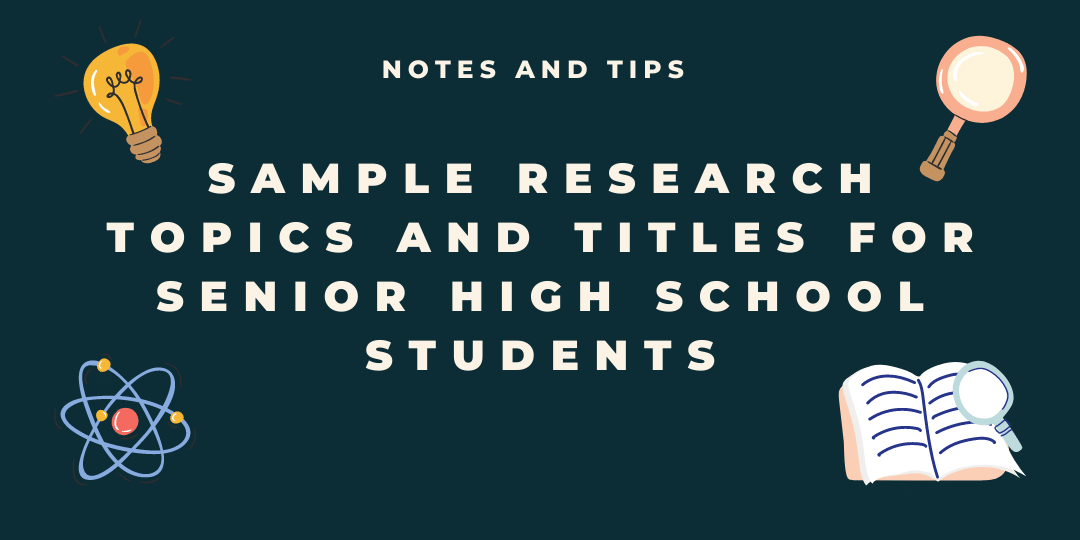
One of the hardest and most challenging times of your senior high school year is doing research. You might have your own group now, and you are currently brainstorming ideas on what topic your research should be about.
Introduction
The process of creating a research title.
A well-crafted title may guide everyone who will read it to the heart of your research. Whether it's research related to science, math, business, a sociological inquiry, or an artistic exploration, it is essential to take note of the following actions.
- Make use of keywords
- Be clear and specific
- Highlight the problem
- Include action words
- Keep it concise
- Avoid jargon as much as possible
- Reflect your approach
- Consider impactful words
- Review and revise
The list can go further, but the most important ones are already highlighted. These things mentioned make us realize that it is more challenging than just picking and combining words. You'll have to brainstorm, follow these things, then revise again if some points still need improvement. After which, you just have to create a suitable title that is not only within your interest but also good enough to be presented on the Title Defense .
It is frustrating and time-consuming to find a suitable topic, but again, through the next sections, you will find various topics on how you will do it. The objective is to provide an insightful and helpful guide by making relevant, insightful, and easy-to-follow recommendations. Let us then identify various areas that this article will talk about:
- For Accountancy, Business and Management Strand
- For General Academic Strand
- For Humanities and Social Studies Strand
- For Science, Technology, Engineering, and Mathematics Strand
Sample Relevant Topics and their Corresponding Titles
Here's what you need to put in mind. The topics and titles presented are just samples and were formulated using the things mentioned above. I know, and I believe that you can do better. But anyway, you are free to use them as your basis for you to make a more suitable research title for your chosen topic.
ABM Strand Research Titles
Consider numbers and strategies if you're into ABM (Accountancy, Business, and Management). You could dive into financial analysis or decipher the impact of a particular method related to marketing strategies on a particular place. You may be considering the economic policies here as well and might be thinking of how they can shake up different parts of the business world.
GAS Research Titles
Under the GAS or General Academic Strand, interdisciplinary studies come first. You may be considering different subjects teaming up to tackle significant challenges. It can also be societal challenges, or you can analyze the efficiency of various teaching approaches. It's broad, and there's a lot to possibly become research topics.
HUMSS Strand Research Titles
The potential research topics for the HUMSS or Humanities and Social Sciences strand include cultural studies, social behavior, community dynamics, and studying the influence of arts and culture on society. Consider understanding the traditions that shape us, or it can be the social behavior and community dynamics, which are like windows, giving us a view into how societies function and develop. It's like looking through these windows to comprehend the heartbeat of various communities.
STEM Strand Research Titles
As for the STEM or Science, Technology, Engineering, and Mathematics strand, possible research topics may encompass technologies, environmental challenges, conducting scientific experiments, or going deeper into mathematical modeling and analysis, such as geometric patterns of certain buildings. It doesn't only feel like you are the incredible scientist in the lab coat. If math is your jam, it is not just about exploring patterns in buildings or just computing things. You may be considering architectural secrets or deciphering the reason behind such patterns through qualitative analysis. There's really a lot to become research topics here.
TVL Track Research Titles
Essential tips for senior high school students.

Embarking on a new journey is an exciting adventure filled with new opportunities and challenges. To make the most of this chapter, here are some essential tips.
While this information is easily accessible on the internet, do not just copy and paste it. Instead, make it your guide and follow the tips in order for you to come up with your own research titles that are inclined with your benefits. The sole purpose of this article is to provide examples and how it can be done using the guide provided. Remember that it is a community for growth and learning.
Good luck in conducting your research!
10 Comments

How about research topis in ICT, agriculture, home economics, carpentry and sports?
How about issues in our surroundings?
How about RALLYING, MARKET AND POOR AREA?
How about for GAS
How about HE for sample research?
How about Cookery for sample research topic?
Any title for humss student
How about for TVL
Hi. Could you please help me in making a research title about IE research? Like ergonomics. Pleasee I'm bad in making this.
How about in Tour guiding students?
Our website uses cookies to improve your experience. To learn more about this, kindly read our Privacy Policy.
Contact Form
Academia.edu no longer supports Internet Explorer.
To browse Academia.edu and the wider internet faster and more securely, please take a few seconds to upgrade your browser .
Enter the email address you signed up with and we'll email you a reset link.
- We're Hiring!
- Help Center

FACTORS AFFECTING THE GRADE 11 STUDENTS CHOOSING GENERAL ACADEMIC STRANDS

Related Papers
Fritz Gerald Martin
Psychology and Education: A Multidisciplinary Journal
Shar-In A. Sadjail , Darwina J. Sansawi , Mona-Allea L. Matolo , Psychology and Education
Deciding for a college course to take is quiet challenging for a student due to the many influencing factors or reasons in the environment that may affect his own preference. This study aimed to determine the factors that influence the College of Education students at MSU-TCTO in choosing Education as their college course. Further, it tried to determine different approaches in managing the course they are currently taking at the college. The result of this study would benefit the administrators, teachers, parents, students, and future researchers as they gain new insights about the factors that influence the students in choosing their college course. This study made use of a phenomenological-qualitative study conducted to the selected students at the College of Education, MSU-TCTO. Interview guide was utilized to gather the needed data. It consists of guide questions validated by the panel of experts. Data gathered were transcribed, thematically analyzed and interpreted. Based on the findings of the study, the common factors that influence the students in choosing Education as their college course were parental discretion/ influences, external influences, affordability, practicality, personal preference and interest, and socioeconomic problems. Moreover, the respondents' yielded different approaches and ways to manage the courses they are currently taking at the College of Education such as self-determination, overcoming fear of subject difficulties, perseverance and self-confidence, personal preference and interest and developing participation and study habit/skills. In conclusion, there were several factors that influenced the COED students in taking Education course. Further, the course they are currently taking were not solely chosen by themselves. The influence of other people in choosing their course may help or hinder them to succeed in life. Hence, appropriate assistance must be provided to students such as seminar or conference on career guidance, among others to assist them with their course placements and help them invest their full potentials.
Assoc. Prof. Dr. Rashad Yazdanifard
On an annual basis, data shows that there are numerous university and college students that fail to complete their courses and graduate with the intended degree or diploma in hand. The aim of this study is to explore the factors that influences the decision making of a student when it comes to choosing varsity courses, investigate how these factors can impact the students’ decisions and provide recommendation on how the cognitive behaviour and academic excellence can be used to make a sound decision, setting the students for success in their varsity life. This research has narrowed down to three major factors which are personal, interpersonal and environmental. The study is conducted using a Likert scale method further expanding the factors into subdivisions for the participants to rank. The population (data set) for this survey is 50 students from all walks of life but concentrated in Klang Valley. The key findings from the study shows the most prominent factor are Personal factors. The second most influential item are Environmental factors. Interpersonal factors come in third. Concluding this research, it is prudent to obtain a bigger and robust data set. A future practical application of this research can be developed by a tool which further provides a systematic solution for all its users to yield the best potential and make the best informed decision when furthering their education.
Daniel Fil Divino
With the changes that are needed to be faced by our country in terms of educational curriculum, the researchers have made a move to pursue this study. In our study, we concluded four (4) major factors which was the basis of this study, Parental Influence, Aptitude, Interests and Environmental Factors. This study aims to find out the significant differences between the career choice factors and the gender of our respondents. The research was conducted at the University of the Immaculate Conception and its respondents were selected Grade 10 students, ranging from 20-23 per section. It was performed using the descriptive survey method, thus, the researchers formulated a questionnaire based on the four (4) different indicators, with six (6) statements each. The questionnaires were distributed in 8 sections, with 172 respondents all in all which was verified through the Slovin’s formula. The researchers then encoded the data to be able to get the mean scores, as well as, the p-value or the significant difference. It was then formulated by the SPSS, and obtained a p-value of 0.144. Therefore, it was implied that there was a significant difference between the career choices of grade 10 students with their gender. The proponents’ decision was to accept the alternative hypothesis and reject the null hypothesis. There are diverse and several factors which can also affect the career choice of an individual. For the improvement of further studies, the researchers highly recommend that there should be other factors that will be looked upon since career choice is essential in one’s future way of life.
liyana hussin
The rapid growth of education in Malaysia nowadays encourage the higher educational institutions to provide the best features of courses which align to national aspirations. The positive competition between public university and private university in the admission of students create the great impact of sustainability of the institutions as well. Thus, this study concentrated to give an overview of the factor that encourage students to choose certain courses in higher educational institutions. The determinants of selection addressed consists of the future career, passion, parental influence and peer influence. As conclusion, this study can help the higher institutions to provide some strategies in increasing the number of admission of students and at the same time improve the academic quality and the governance of institution. Keywords: higher educational institutions, determinant of selections, strategies
Vinthuja Murukesampillai
Choice of stream is vital for every student future successful career path. Now-a-days students are facing problem when they have to choice the stream. In this view several factors are behinding for the selection of Advanced Level Stream. According to the Sri Lankan education system has five streams namely Physical science, Biological science, Commerce, Arts and Technical. Out of them, students are compulsory undertaking one. The objective of this study is to determine the factors which influence on choice of Advanced Level stream among Ordinary Level students of Jaffna district schools in Sri Lanka. The factors are investigated like personal interest, skills & knowledge enhancement, work related concern, parental relations, friends involvement and financial support. The study was conducted by using survey design with a convenience sampling of Jaffna district schools. The data for this study has been collected by using direct personal interview. The findings of this study revealed that Personal factors are most influencing when choosing of Advanced Level Stream among Ordinary Level students of Jaffna district schools in Sri Lanka. As well as following other factors influencing like family and friends, financial background, school restrictions and job opportunities.
International Journal of Scientific and Research Publications (IJSRP)
Jerald Moneva
Acta Didactica Napocensia
Simona Sava
International Journal of Educational Research Review
Yasin BAYRAKTAR
Journal of Vocational Education Studies
Muhammad Sayuti
The purpose of the study was to analyze the influence of parental guidance, peer group, school promotion, and career information on course preference decision. This study applied a mixed-method with quantitative (multiple regression) followed by the qualitative stage. The quantitative analysis technique is done by a regression test and continued with qualitative. The results showed that partially and simultaneously, the variables of parental guidance, peer groups, school promotion, and career information affected the decision making in choosing the competency of students of SMK Muhammadiyah in Bantul. Career information factors of 12.98% most influence students' decision making in choosing expertise competencies. School promotion contributed 8.20% of the decision. The peer factor contributes to 4.78% of the students’ choices. The last of these factors was parental guidance, which provided 4.43%.
RELATED PAPERS
philip Mendes
claudio carcamo
Panos Zachariadis
Intensive and Critical Care Nursing
Tatiele Arrial
Gülbeniz Akduman
Giampiero Neri
Andrew Penland
Alain Piveteau
Materials Advances
Vladimir Matvijenko
Medycyna Ogólna i Nauki o Zdrowiu
Barbara Ślusarska
Direito Público
Marcos Botelho
CERN European Organization for Nuclear Research - Zenodo
Timotei Rusu
2016 European Control Conference (ECC)
Harsh shukla
Moti Tolera
Dimitri D'Andrea , laura bazzicalupo
Building and Environment
Ariel Edmundo Tarazona Pedraza
LARHYSS Journal
Lahcen Benaabidate
Zenodo (CERN European Organization for Nuclear Research)
Khachatur Nerkararyan
Journal of the American Chemical Society
Dequan Xiao
Annals of Oncology
Wolfgang Söllner
IEICE Transactions on Communications
Masato Tsuru
Arash Eshghi
- We're Hiring!
- Help Center
- Find new research papers in:
- Health Sciences
- Earth Sciences
- Cognitive Science
- Mathematics
- Computer Science
- Academia ©2024

The Teaching of Senior High School General Academic Strand (Gas)
- Rea Myricar Arellaga
Introduction
This study aimed to identify the teaching of Senior High School General Academic Strand (GAS) Teachers in the City Schools Division of Urdaneta and the problems encountered with an end view of an intervention program for a more effective Senior High School implementation.
The research work used percentage and means to analyze profiles and responses and Pearson r to determine whether the relationship between profile and practices existed. This study utilized the descriptive survey method involving all thirty-three (33) Senior High School GAS teachers in the City Schools Division of Urdaneta during the school year 2016-2017.
The majority of the respondents are females who are in their early middle age period and educationally qualified. The Senior High School GAS teachers effectively practiced teaching in terms of Curriculum Development, Teacher Preparation, and Teaching Strategies. Sex influences the teaching of Senior High School GAS teachers along with curriculum development. Moreover, the respondent's highest educational attainment and position remarkably influence teaching along Teacher Preparation. The problems the teachers encountered are Slightly Serious and they are manageable. The intervention program in the study is a viable alternative for more effective teaching in Senior High School GAS.
Discussions
In light of the significant findings and conclusions drawn, the researcher recommends that the teacher-respondents must pursue their master's degree or doctoral degree for their professional growth and development. Thus, making them more effective, dedicated and committed to their profession. Participation in in-service training, seminars, and Learning Action Cell (LAC) sessions should also be pursued. They should also keep themselves up-to-date with the current educational trends. The school heads and teachers should also strengthen linkages with the community and other stakeholders so that they may know the problems related to the implementation of K to 12 and that they may provide assistance. This will further strengthen the school-community relationship. The schools should also adopt more innovative trends, improving their facilities and preparing themselves for globalization through the utilization of multimedia. The adoption of the inferences derived should be considered by school heads and teachers.
Information
- For Readers
- For Authors
- For Librarians
©2017 by Ascendens Asia Pte. Ltd. | NLB Singapore-Registered Publisher.


General Academic Strand (GAS)
Overview of gas.
Designed to prepare students who are more inclined to general areas of study rather than specialized fields, GAS will present the option for SHS students to take their electives from specialized subjects of any other strands.
The Objectives of the GAS
The GAS is ideal for those who are still undecided about which career path they want to pursue in the future. GAS aims to:
- Cover various subjects and topics including Humanities, Social Sciences, Organization, and Management
- Give students the freedom and ability to pursue any undergraduate program under the three other strands in the future
- Develop your communication and writing skills
- Learn about Empowerment Technologies

Advantages of the GAS
The GAS gives senior high school students exposure a variety of different subjects, allowing them to explore each one to see which will be the best fit for them. With GAS, students can:
- Take a wide selection of subjects including Disaster Preparedness, Risk Reduction, And Organization Management
- Enjoy a balanced mix of subjects from the other SHS strands namely HUMSS, ABM, and STEM
- Make a more informed decision regarding their undergraduate program and future career path because they have learned a host of different subjects
Courses to Take After Senior High School
SHS graduates of the GAS strand can enroll in the following undergraduate courses:
- Bachelor of Science in Multimedia Arts and Sciences
- Bachelor of Fine Arts in Digital Cinema
- Bachelor of Science in Interior Design
- Bachelor of Science in Physical Education

Possible Career Paths with the GAS
Senior high school graduates of the GAS can have successful careers as the following:
- Businessmen
- Psychologists
- Journalists
- Multimedia Designers
- Interior Designers
- Social Workers
General Academic Strand Curriculum
Unlike other strands, the senior high school GAS gives students a more general overview on the different subjects rather than a focused approach. In this strand, students receive a holistic education that tackles subjects from each of the different strands – HUMSS, STEM, and ABM. General academic strand subjects are ideal for students who want a well-rounded educational experience that opens the doors to various career and education paths to explore after graduation. Some of the GAS strand subjects in our curriculum include:
- Oral Communication in Context
- Reading and Writing Skills
- 21st Century Literature from the Philippines and the World
- Understanding Culture, Society and Politics
- Earth and Life Science
- Physical Science
- Introduction to the Philosophy of the Human Person
- General Mathematics
- Statistics and Probability
- Physical Education and Health 1 & 2
- English for Academic and Professional Purposes
- Research in Daily Life 1
- Empowerment Technologies: ICT for Professional Tracks
- Organization and Management
- Introduction to World Religions and Belief Systems
- Disciplines and Ideas in the Social Sciences
- Trends, Networks, and Critical Thinking in the 21st Century Culture
GAS stands for General Academic Strand. Through the GAS, senior high school students are given exposure to different courses so they can make a more informed decision about their future career path. GAS gives a more generalized approach towards educating the students, rather than focusing on one or two fields, allowing students to explore their options.
It’s important to remember that there is no right or wrong strand or track. When it comes to choosing a strand, students just have to choose one that they are genuinely interested in or would like to pursue in the future, as the strand they choose will provide them with the knowledge and skills they’ll need in college or future employment.
Under GAS, SHS graduates can get jobs as teachers, doctors, lawyers, businessmen, accountants, engineers, social workers, designers, psychologists – practically any job under the three other strands!
GAS is a very versatile strand because it does not focus on any single career path. This gives students the freedom to explore their options and gives them a good mix of subjects so they can make a more informed decision when it comes to choosing an undergraduate degree in the future.
No, you do not need to answer an entrance test to apply to OEd Senior High School. Senior high school applicants only need to fill out the application form online and submit their requirements via email. Once we have received all your requirements, we will evaluate your application before informing you of our decision. Please take note that this may take anywhere between 24 to 48 hours.
New K11 students are expected to submit the following:
- Successful Online Registration;
- Form 138/ Grade 10 Card;
- Certificate of Completion;
- Certificate of Good Moral;
- NSO Certified Birth Certificate;
- Form 137 or the Transcript of Records (School-to-School Transaction)
The tuition fee and other fees vary per program. Course Fee is charged on a per-course basis. To learn more about OED fees, please register at oedportal.amauonline.com or chat with us on facebook.com/OEducPh

AMA University Online Education (AMAOEd) is an online SHS education platform in the Philippines.
Quick Links
- Social Highlights
Academic Programs
- Online Basic Education
- Online Junior High School
- Online Senior High School
Academic Tracks
- Junior High Requirements
- Senior High Requirements
Contact Information
- [email protected]
- Mizheal +639171901136
- Stefany +639171803256
AMA GROUP OFFICIAL WEBSITES | OEd.com.ph | OnlinePostGrad.com 2021 © OEd Senior High School. All Rights Reserved.
Privacy Policy | Sitemap
What are the main research topics in the GAS Strand?
The main research topics in the GAS Strand include the study of $G$-strand equations in the context of broken symmetries described by symmetric spaces, the investigation of the innate immune system's sensing of cytosolic nuclear acids and the role of cGAS in this process, the examination of the structure and activation mechanisms of cGAS, the discovery of physiological nucleic acid ligands of cGAS, and the understanding of cGAS's role in controlling DNA replication and suppressing replication-associated DNA damage .
Answers from top 4 papers
Citation Count
Related Questions
See what other people are reading.

112+ Easy Quantitative Research Topics for Gas Students
If you’re a gas student looking for research inspiration, you’re in the right place! We’ve gathered 115 easy quantitative research topics for gas students. These topics cover various aspects of gas, from its impact on the environment to its role in our daily lives.
Gasoline, natural gas, and other forms of gas play a significant role in our world, affecting everything from our cars to our environment. With these research topics, you can explore how gas influences our lives, our planet, and our future.
Whether you’re interested in the science of gas, its economic aspects, or its impact on society, there’s a topic here for you. Let’s dive into these research ideas and find the perfect one to kickstart your gas-related research project!
Table of Contents
1. The Impact of Gas Emissions on Climate Change: Analyze the correlation between greenhouse gas emissions and global warming.
2. Energy Efficiency in Gasoline Engines: Investigate ways to improve fuel efficiency in gasoline-powered vehicles.
3. Gas Pricing and Consumer Behavior: Examine how fluctuations in gas prices influence consumer spending habits.
4. Gas Leakage Detection Technologies: Evaluate the effectiveness of various technologies for detecting gas leaks in residential and industrial settings.
5. Air Quality in Urban Areas: Analyze the relationship between gas emissions and air quality in densely populated cities.
6. The Use of Natural Gas in Power Generation: Compare the efficiency and environmental impact of natural gas power plants with other energy sources.
7. Gasoline Additives and Engine Performance: Investigate the effects of gasoline additives on engine performance and emissions.
8. Gas Supply Chain Management: Study the logistics and efficiency of the natural gas supply chain.
9. Renewable Energy Integration with Gas Grids: Explore the possibilities of integrating renewable energy sources with existing gas grids.
10. Gas Flaring and Environmental Consequences: Assess the environmental impact of gas flaring in oil production.
11. Gasoline Taxes and Their Effects: Analyze the impact of gasoline taxes on fuel consumption and government revenue.
12. Methane Emissions from Livestock: Investigate the contribution of methane emissions from livestock to greenhouse gas levels.
13. Gasoline Subsidies and Economic Development: Study the economic implications of government gasoline subsidies in developing countries.
14. Gasoline Octane Ratings and Engine Efficiency: Examine the relationship between octane ratings and engine performance.
15. Hydrogen as a Clean Gas Alternative: Explore the potential of hydrogen as a clean alternative to fossil fuels.
16. Gasoline Consumption Patterns by Age and Gender: Analyze how age and gender influence gasoline consumption.
17. Gasoline Composition and Emissions: Investigate how the chemical composition of gasoline affects emissions.
18. Gasoline Marketing and Consumer Preferences: Study the impact of marketing strategies on consumer preferences for gasoline brands.
19. Gasoline Prices and Public Transportation Use: Analyze how fluctuations in gas prices influence the use of public transportation.
20. Gasoline Quality Standards: Evaluate the effectiveness of quality standards in regulating gasoline production.
21. Gasoline Alternatives for Two-Wheelers: Explore alternative fuels for motorcycles and scooters.
22. Gasoline Vapor Recovery Systems: Investigate the effectiveness of vapor recovery systems at gas stations.
23. Gasoline Consumption in Rural vs. Urban Areas: Compare gasoline consumption patterns in rural and urban regions.
24. Electric Vehicles vs. Gas-Powered Vehicles: Analyze the environmental and economic aspects of electric vehicles compared to traditional gas-powered vehicles.
25. Gasoline Rationing Policies during Crises: Study the impact of gasoline rationing policies during fuel shortages.
26. Gasoline Volatility and Safety Measures: Examine safety measures related to the volatility of gasoline.
27. Gasoline Price Elasticity: Investigate how changes in gasoline prices affect consumer demand.
28. Gasoline Combustion Efficiency: Analyze methods to improve the combustion efficiency of gasoline engines.
29. Gasoline Shortages and Black Markets: Study the emergence of black markets during gasoline shortages.
30. Gasoline Storage and Safety: Evaluate safety protocols for storing gasoline at home.
31. Gasoline Substitutes for Cooking: Explore alternative cooking fuels to reduce reliance on gasoline.
32. Gasoline Sulfur Content and Environmental Impact: Analyze the environmental consequences of sulfur content in gasoline.
33. Gasoline Consumption and Tourism: Investigate the relationship between gasoline consumption and tourism trends.
34. Gasoline Quality Control in Developing Countries: Study the challenges of ensuring gasoline quality in developing nations.
35. Gasoline Transportation and Distribution Networks: Analyze the efficiency of gasoline transportation and distribution systems.
36. Gasoline Price Transparency: Investigate the availability of price information and its impact on consumer choices.
37. Gasoline Use in Agriculture: Study the role of gasoline in modern agricultural practices.
38. Gasoline-Ethanol Blends and Performance: Examine the effects of ethanol blends on engine performance and emissions.
39. Gasoline Consumption Behavior during Economic Downturns: Analyze how economic recessions influence gasoline consumption patterns.
40. Gasoline and Air Pollution: Investigate the relationship between gasoline consumption and air pollution.
41. Gasoline Efficiency in Hybrid Vehicles: Study the efficiency of gasoline engines in hybrid cars.
42. Gasoline Taxes and Cross-Border Shopping: Analyze how gasoline taxes affect cross-border shopping for fuel.
43. Gasoline Price Wars and Market Competition: Investigate the dynamics of price wars among gasoline stations.
44. Gasoline Use in Emergency Response Vehicles: Study the fuel efficiency of emergency response vehicles.
45. Gasoline Price Forecasting Models: Develop models to predict future gasoline prices.
46. Gasoline and Tourism Industry: Analyze the impact of gasoline prices on the tourism industry.
47. Gasoline Production and Environmental Regulations: Investigate the compliance of gasoline producers with environmental regulations.
48. Gasoline Consumption and Commuting Habits: Study how commuting habits influence gasoline consumption.
49. Gasoline Taxation Policies and Government Revenue: Analyze the revenue generated by gasoline taxation.
50. Gasoline Use in Small Businesses: Investigate the role of gasoline in the operations of small businesses.
51. Gasoline and Urban Planning: Examine how urban planning can reduce gasoline consumption.
52. Gasoline Use in Agricultural Equipment: Analyze the fuel efficiency of tractors and other agricultural machinery.
53. Gasoline Storage and Underground Tanks: Investigate the safety of underground gasoline storage tanks.
54. Gasoline and Tourism Destination Choices: Study how gasoline prices influence tourists’ choice of destinations.
55. Gasoline Use in Construction Industry: Analyze the role of gasoline in the construction sector.
56. Gasoline Consumption and Public Health: Investigate the health effects of gasoline emissions on communities.
57. Gasoline Quality and Vehicle Maintenance: Examine how gasoline quality affects vehicle maintenance.
58. Gasoline Price Shocks and Economic Recession: Analyze the relationship between sudden gasoline price increases and economic downturns.
59. Gasoline Demand Forecasting: Investigate methods for accurately forecasting gasoline demand.
60. Gasoline and Food Delivery Services: Study the impact of gasoline prices on food delivery services.
61. Gasoline Use in Boating and Recreational Vehicles: Analyze the fuel efficiency of boats and RVs.
62. Gasoline and Pollution in Developing Cities: Investigate the role of gasoline in air pollution in rapidly growing cities.
63. Gasoline Tax Evasion and Enforcement: Examine strategies for preventing gasoline tax evasion.
64. Gasoline Price Manipulation: Analyze instances of price manipulation in the gasoline industry.
65. Gasoline and Freight Transportation: Investigate the impact of gasoline prices on the cost of goods transportation.
66. Gasoline and Food Prices: Study the correlation between gasoline prices and food prices.
67. Gasoline Use in School Buses: Analyze the fuel efficiency of school buses.
68. Gasoline and Alternative Transportation: Investigate the adoption of alternative transportation methods due to rising gasoline prices.
69. Gasoline Consumption and Carpooling: Analyze carpooling trends and their impact on gasoline consumption.
70. Gasoline and Ride-Sharing Services: Investigate the relationship between ride-sharing services and gasoline consumption.
71. Gasoline Use in Military Operations: Study the role of gasoline in military logistics.
72. Gasoline and the Gig Economy: Analyze how gig workers are affected by gasoline prices.
73. Gasoline and Telecommuting: Investigate the relationship between telecommuting and gasoline consumption.
74. Gasoline and Consumer Preferences for Electric Vehicles: Analyze factors influencing consumers’ choices between gasoline and electric vehicles.
75. Gasoline Use in Long-Haul Trucking: Study the fuel efficiency of long-haul trucks.
76. Gasoline and Air Travel: Investigate the impact of gasoline prices on air travel trends.
77. Gasoline and Freight Rail Transport: Analyze the efficiency of freight rail compared to gasoline-powered trucks.
78. Gasoline and Public Transportation Infrastructure: Study the relationship between gasoline consumption and investments in public transportation.
79. Gasoline and Food Distribution: Investigate the role of gasoline in the distribution of perishable goods.
80. Gasoline and Shipping Industry: Analyze the fuel efficiency of cargo ships.
81. Gasoline and the Green Energy Transition: Investigate how the transition to green energy affects gasoline consumption.
82. Gasoline Use in Emergency Power Generators: Study the use of gasoline in backup power generators.
83. Gasoline and Sustainable Agriculture: Analyze the role of gasoline in sustainable farming practices.
84. Gasoline and Supply Chain Disruptions: Investigate how supply chain disruptions affect gasoline availability.
85. Gasoline and Telecommunications: Study the role of gasoline in maintaining telecommunications infrastructure.
86. Gasoline and Disaster Response: Analyze the role of gasoline in disaster relief efforts.
87. Gasoline and Emergency Medical Services: Investigate the fuel efficiency of ambulances and emergency medical vehicles.
88. Gasoline and Water Supply: Study the role of gasoline in water supply systems.
89. Gasoline and Public Safety: Analyze the impact of gasoline shortages on public safety services.
90. Gasoline and Agriculture Irrigation: Investigate the use of gasoline in irrigation systems.
91. Gasoline and Wildlife Conservation: Study the environmental impact of gasoline use in wildlife conservation efforts.
92. Gasoline and Infrastructure Development: Analyze how gasoline availability influences infrastructure development.
93. Gasoline and Disaster Preparedness: Investigate the role of gasoline in disaster preparedness plans.
94. Gasoline and Healthcare: Study the impact of gasoline shortages on healthcare services.
95. Gasoline and Education: Analyze the role of gasoline in education, including school transportation.
96. Gasoline and Emergency Response Coordination: Investigate how gasoline shortages affect coordination among emergency response agencies.
97. Gasoline and National Security: Study the national security implications of gasoline availability.
98. Gasoline and Remote Work: Analyze how remote work trends impact gasoline consumption.
99. Gasoline and Water Treatment Plants: Investigate the role of gasoline in maintaining water treatment facilities.
100. Gasoline and Disaster Recovery: Study the use of gasoline in post-disaster recovery efforts.
101. Gasoline and Police Services: Analyze the role of gasoline in police department operations.
102. Gasoline and Environmental Conservation: Investigate the impact of gasoline use on environmental conservation efforts.
103. Gasoline and Transportation Equity: Study how gasoline availability affects transportation equity in communities.
104. Gasoline and Disaster Communication: Analyze the role of gasoline in maintaining communication during disasters.
105. Gasoline and Emergency Shelter: Investigate the use of gasoline in emergency shelter operations.
106. Gasoline and Emergency Food Distribution: Study the role of gasoline in food distribution during emergencies.
107. Gasoline and Emergency Medical Supplies: Analyze the use of gasoline in transporting medical supplies during crises.
108. Gasoline and Emergency Water Supply: Investigate the role of gasoline in providing emergency water supply.
109. Gasoline and Disaster Cleanup: Study the use of gasoline in disaster cleanup efforts.
110. Gasoline and Hazardous Material Transport: Analyze the safety measures for transporting hazardous materials using gasoline.
111. Gasoline and Disaster Relief Coordination: Investigate how gasoline shortages affect coordination among relief organizations.
112. Gasoline and Disaster Evacuation: Study the role of gasoline in disaster evacuation plans.
113. Gasoline and Disaster Medical Services: Analyze the use of gasoline in providing medical services during disasters.
114. Gasoline and Emergency Transportation: Investigate the role of gasoline in emergency transportation services.
115. Gasoline and Disaster Preparedness Education: Study the role of gasoline in educating communities about disaster preparedness.
These 112+ easy quantitative research topics for gas students offer a wide range of exciting possibilities for exploration. Whether you’re passionate about the environment, technology, economics, or social issues related to gas, there’s a topic that can ignite your curiosity.
As a student studying gas, you have a unique chance to add valuable insights to our knowledge of how this essential resource affects our world. Remember, research is not only about finding answers but also about asking the right questions.
By selecting one of these research topics and delving into it, you can deepen your knowledge, enhance your critical thinking abilities, and leave a positive mark on the field of gas studies. So, pick a topic that resonates with you, gather your data, and embark on your research journey. Your discoveries could help shape a cleaner, more sustainable future for us all.
Leave a Comment Cancel reply
Save my name, email, and website in this browser for the next time I comment.
General Academic Strand (GAS)
While the other strands are career-specific, the General Academic Strand is great for students who are still undecided on which track to take. You can choose electives from the different academic strands under this track. These subjects include Humanities, Social Sciences, Applied Economics, Organization and Management, and Disaster Preparedness.
How many students take this strand?
This is the highest senior high enrolment in the Academic track.
* As of September 2016
Which schools offer this strand?
What are the subjects in this strand?
Some subjects offered are Humanities, Social Sciences, Applied Economics, Organization and Management, and Disaster Preparedness.
Making a Da Vinci in you? Humanities can be any of the specialized subjects in the Humanities and Social Sciences (HumSS) Strand. This could be Creative Writing / Malikhaing Pagsulat; Introduction to World Religions and Belief Systems; Creative Nonfiction; Trends, Networks, and Critical Thinking in 21st Century Culture.
Social Science
Want to become the next President? Social Science subjects can be Philippine Politics and Governance; Community Engagement, Solidarity, and Citizenship; Disciplines and Ideas in the Social Sciences; Disciplines and Ideas in the Applied Social Sciences.
Applied Economics
Gearing up to be the new Mareng Winnie? Applied Economics will discuss basic economic problems of the country; analyze market structures; and study strategies to minimize negative impact and maximize positive impact of businesses in the community.
Organization and Management
Thinking of managing an enterprise? Organization and Management introduces students to analytical tools like Political Economic Social and Technological (PEST) and Strengths Weaknesses Opportunities and Threats (SWOT) that can be used when starting business ventures.
Disaster Readiness and Risk Reduction
Seeing yourself as Mang Tani? Through Disaster Readiness and Risk Reduction, students will analyze disasters from different perspectives; explain and differentiate disasters; and identify areas that are exposed and prone to destructive calamities.
If you are still looking for the right strand or if you already have made a decision, you can take electives from the specialized subject of any other Track or Strand to help you with your choice.
Other academic Strands
Other High School Tracks
Job-ready skills
Physical education and recreation
Design, performative, and creative industry

General Academic Strand (GAS)

Are you not sure yet about your interests? Take the General Academic Strand (GAS). Unlike other K to 12 tracks and strands that are specific to a career, GAS gives you the chance to weigh your options.
GAS is a Senior High School strand that takes on a generalist approach in preparing students for college. It covers various disciplines like Humanities, Social Sciences, Organization, and Management.
Since GAS does not specialize in any strand, you are free to choose any college degree program under the three other strands based on the elective you will choose. Moreover, a possible course to pursue from this strand is Education.
What you will gain from the GAS Strand:
- Hone you creative writing skills.
- Learn about Organization Management.
- Learn about Empowerment Technologies.
- Gain knowledge of Disaster Readiness and Risk Reduction.
- Develop your communication skills.
e-Learning or Online Learning is available across all SHS strands.
What's Happening?

Are you employment-ready? Get real-life skills and work experience through the Informatics+ Blended Learning Program
Are you employment-ready? Get real-life skills and work experience through the Informatics+ Blended Learning Program In its mission to […]
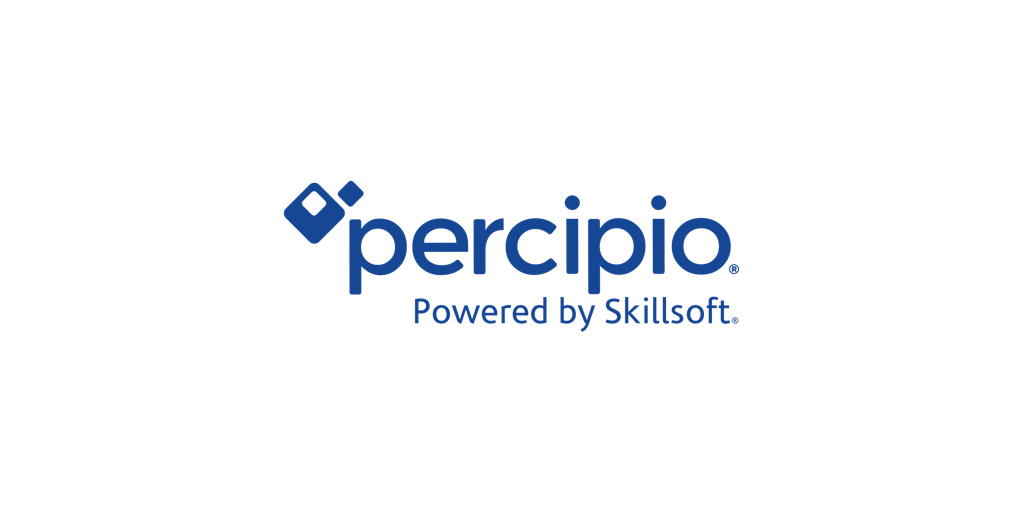
Informatics offers over 8,000 digital courses to upskill employees through global learning platform Skillsoft Percipio
Informatics offers over 8,000 digital courses to upskill employees through global learning platform Skillsoft Percipio In its mission to […]

In-demand Homebased Jobs for Filipinos
Working from home may be a different set-up from the traditional office set-up, but it certainly offers a lot of benefits, especially in the new normal. As people are bound to stay at home most of the time during the pandemic, home-based jobs offer a ray of hope to the economy and the people in need of an alternative livelihood.
If you are looking for a job or you are considering a career shift, home-based jobs are something that you should consider. Working from home gives you location independence, sparing you from the stressful daily commute and allowing you to save more money. It will also give you some flexibility in terms of time management.
Privacy Overview
64 Natural Gas Essay Topic Ideas & Examples
🏆 best natural gas topic ideas & essay examples, 👍 good research topics about natural gas, 📌 most interesting natural gas topics to write about.
- Gas Hydrates: Techniques of Extraction and Its Potential as an Alternative to Natural Gas The objectives of the given research are to consider the positive and the negative aspects of each gas hydrate production methods, as well as to revisit the alternatives to the gas hydrate use, which will […]
- Safe Transportation of Liquefied Natural Gas Be that as it may, a raft of proposals is still required to improve the effectiveness of the measures of enhancing the safety of LNG transportation. We will write a custom essay specifically for you by our professional experts 808 writers online Learn More
- Natural Gas Utilization Master-Plan in Nigeria The novelty of the project lies in the fact that it takes up on previous studies that have examined the issues surrounding the Nigerian natural gas economy. To examine energy utilization factors in Nigeria relevant […]
- Safety, Health and Environmental Issues in Liquefying Methane From Algerian Natural Gas As one of the leading producers of liquefied natural gas in the world, the demand for this natural resource from Algeria is growing by the day.
- Alberta Royalty Review Panel: Natural Gas and Oil Fields Hunter and the panel of experts have compiled the report to quantify the main grievance of the people of Alberta, Canada, that the people in this province do not receive a fair share of the […]
- Natural Gas and Environmentalists Views As noted by BP, “Natural gas is expected to grow faster than oil or coal, helped by the rapid growth of liquefied natural gas increasing the accessibility of gas across the globe”.
- Technology for Cheaper Natural Gas Prices The nature of the targeted arrangement is that these corporations will utilize most of their resources and innovations to deliver every outlined objective.
- Liquefied Natural Gas in Qatar It is noted that the increasing volumes of gas production in Qatar, along with the need of a number of countries for its supplies, indicate the confidence of the world in Qatar.
- Global Natural Gas Prices in 1940-2015 Moreover, oscillations of the price of natural gas lead to significant changes in the market and can result in the appearance of the world financial crisis.
- Industry Changes: Floating Liquefied Natural Gas The entire process from extracting natural gas to delivering it to the market will be modified by the FLNG model, which makes FLNG a game-changer in the industry.
- Liquefied Natural Gas Market, Supply and Demand This will create the shift in a supply curve, leading to the creation of the new equilibrium for Europe and the USA.
- Oil and Natural Gases in Eurasian Region In other words, the oil and natural gas industry is an investment that holds the economy of the various states in Eurasia, and, therefore, the energy sector holds the power of the survival of these […]
- Hydraulic Fracking for Natural Gas Extraction in Pennsylvania Moreover, the industry has embarked on the use of advanced technologies to ensure the safety and efficiency of the extracted gas through fracking.
- Means of Mining Shale Natural Gas The invention of cheaper means of mining shale natural gas has resulted in an increase in production of gas in the U.S.
- Liquefied Natural Gas Growth and Development Due to the safe properties of LNG and due to strict adherence of codes, standards and guidelines applying to LNG, LNG industry is being considered as one of the safeties fuel in meeting the global […]
- Liquefied Natural Gas Role in Catering the Energy Demands Immediately, after the discovery of LNG in the North Sea of UK, import of LNG was ceased by UK and however due to recent fall in the reserves of gas, which compelled the UK to […]
- Production of Liquefied Natural Gas 1 billion is assumed that it would strongly attract ANOC in considering Exxon Mobil as the best foreign company in exploring and producing gas that will be shipped to the East coast of the U.S.
- Natural Gas, Oil, Coal, and Uranium in Russia The country holds the largest natural gas reserves and is among the top ten in terms of crude oil reserves. In addition, Russia is the fifth producer and the third largest exporter of coal in […]
- Environmental Effects of the Production of Electricity by Various Energy Sources: Natural Gas vs. Its Alternatives Speaking of the effects of a power plant that is run on natural gas, it is necessary to point out that the effects on the environment are drastic, as a rule, seeing how the use […]
- The Natural Gas Industry in US The use of the natural gas in the United States of America has increased compared to the recent past. The evolution of the natural gas markets is likely to be determined by the unconventional natural […]
- Natural Gas Drilling and Health Effects on the Community The natural gas drilling usually has effects on both the environment as well as the community as it affects the air, water and the soil as well as the people who live near the drilling […]
- Oil and Natural Gas Industry and Its Effect on the Economy The Purpose of the Research The main purpose of the research is to consider how oil and gas industry affects the economy of the country.
- Evaluation of US Natural Gas Industry The Act’s aim was to protect the consumers from the emerging monopolies in the natural gas industry through price regulation of the natural gas.
- Gas Infrastructure: Liquified Natural Gas It is important to note that, this type of fuel is a fossil fuel and is composed of hydrogen and carbon compounds; hence it is categorized as a hydrogen carbon fuel.
- Supply and Demand Trends and Plans for Natural Gas in South Korea
- Public Transportation and the Use of Compressed Natural Gas
- The Relationship between Crude Oil and Natural Gas Prices: The Role of the Exchange Rate
- The European Natural Gas Market: Imports to Rise Considerably
- Technology and the Prospects for Natural Gas Results of Current Gas Studies
- Russian Natural Gas Exports to Europe. Effects of Russian Gas Market Reforms and the Rising Market Power of Gazprom
- Poverty and Social Impact Analysis of Increased Natural Gas Prices and Selected Social Guarantees in Ukraine
- The Technology and Cost Structure of a Natural Gas Pipeline: Insights for Costs and Rate-Of-Return Regulation
- Trading Volume, Maturity and Natural Gas Futures Price Volatility
- Price Comovement Between Biodiesel and Natural Gas
- Price Controls and the Natural Gas Shortage
- Russian Natural Gas Policy and Its Possible Effects on European Gas Markets
- Theoretical and Numerical Analysis on Pressure Recovery of Supersonic Separators for Natural Gas Dehydration
- The Switching Relationship Between Natural Gas and Crude Oil Prices
- The Weak Tie Between Natural Gas and Oil Prices
- Strategic Storage and Market Power in the Natural Gas Market
- Strategic Investment and International Spillovers in Natural Gas Markets
- Time Series Analysis Applied to Construct Us Natural Gas Price Functions for Groups of States
- Understanding the Risks and Benefits of Importing Liquefied Natural Gas
- The Price and Income Elasticity of China’s Natural Gas Demand: A Multi-Sectoral Perspective
- Transitioning the Tax System to Take Advantage of the Natural Gas-Rich Economy in Trinidad and Tobago
- The Reasons for Measuring the Moisture Content in Natural Gas
- The Fundamentals Underlying Oil and Natural Gas Derivative Markets
- Regulation and Long-term Contracting in U.S. Natural Gas Markets
- U.S. Energy Crisis and Increased Need for Natural Gas
- The Supply, Demand, and Average Price of Natural Gas under Free-Market Conditions
- The Resource And Product Market Of Natural Gas Production
- Predicting the Discoveries and Finding Costs of Natural Gas: the Example of the Scotian Shelf
- Price Convergence and Information Efficiency in German Natural Gas Markets
- The Global Natural Gas Market: Will Transport Cost Reductions Lead to Lower Prices
- Pollution Issues and Liquefaction of Natural Gas
- The Short-Run Residential Demand for Natural Gas
- The FPC Staff’s Econometric Model of Natural Gas Supply in the United States
- Using Natural Gas Generation to Improve Power System Efficiency in China
- Open Access and the Emergence of a Competitive Natural Gas Market
- The World Gas Model: A Multi-Period Mixed Complementarity Model for the Global Natural Gas Market
- Using Natural Gas Transmission Pipeline Costs to Estimate Hydrogen Pipeline Costs
- Optimization for Design and Operation of Natural Gas Transmission Networks
- Single and Multiple Objective Optimization of a Natural Gas Liquefaction Process
- Trade Quotas And Buyer Power, With An Application To The E.U. Natural Gas Market
- Chicago (A-D)
- Chicago (N-B)
IvyPanda. (2023, January 24). 64 Natural Gas Essay Topic Ideas & Examples. https://ivypanda.com/essays/topic/natural-gas-essay-topics/
"64 Natural Gas Essay Topic Ideas & Examples." IvyPanda , 24 Jan. 2023, ivypanda.com/essays/topic/natural-gas-essay-topics/.
IvyPanda . (2023) '64 Natural Gas Essay Topic Ideas & Examples'. 24 January.
IvyPanda . 2023. "64 Natural Gas Essay Topic Ideas & Examples." January 24, 2023. https://ivypanda.com/essays/topic/natural-gas-essay-topics/.
1. IvyPanda . "64 Natural Gas Essay Topic Ideas & Examples." January 24, 2023. https://ivypanda.com/essays/topic/natural-gas-essay-topics/.
Bibliography
IvyPanda . "64 Natural Gas Essay Topic Ideas & Examples." January 24, 2023. https://ivypanda.com/essays/topic/natural-gas-essay-topics/.
- Gas Prices Research Topics
- Economic Topics
- Electric Vehicle Paper Topics
- Nuclear Weapon Essay Topics
- Enron Topics
- Gasoline Prices Ideas
- Environmentalism Essay Topics
- Greenhouse Gases Research Ideas
- Atmosphere Questions
- Exxon Ideas
- Agriculture Essay Ideas
- BHP Billiton Topics
- Alternative Energy Paper Topics
- International Politics Questions
- Acquisition Essay Ideas
- Open access
- Published: 10 March 2020
Research and trends in STEM education: a systematic review of journal publications
- Yeping Li 1 ,
- Ke Wang 2 ,
- Yu Xiao 1 &
- Jeffrey E. Froyd 3
International Journal of STEM Education volume 7 , Article number: 11 ( 2020 ) Cite this article
167k Accesses
151 Citations
5 Altmetric
Metrics details
With the rapid increase in the number of scholarly publications on STEM education in recent years, reviews of the status and trends in STEM education research internationally support the development of the field. For this review, we conducted a systematic analysis of 798 articles in STEM education published between 2000 and the end of 2018 in 36 journals to get an overview about developments in STEM education scholarship. We examined those selected journal publications both quantitatively and qualitatively, including the number of articles published, journals in which the articles were published, authorship nationality, and research topic and methods over the years. The results show that research in STEM education is increasing in importance internationally and that the identity of STEM education journals is becoming clearer over time.
Introduction
A recent review of 144 publications in the International Journal of STEM Education ( IJ - STEM ) showed how scholarship in science, technology, engineering, and mathematics (STEM) education developed between August 2014 and the end of 2018 through the lens of one journal (Li, Froyd, & Wang, 2019 ). The review of articles published in only one journal over a short period of time prompted the need to review the status and trends in STEM education research internationally by analyzing articles published in a wider range of journals over a longer period of time.
With global recognition of the growing importance of STEM education, we have witnessed the urgent need to support research and scholarship in STEM education (Li, 2014 , 2018a ). Researchers and educators have responded to this on-going call and published their scholarly work through many different publication outlets including journals, books, and conference proceedings. A simple Google search with the term “STEM,” “STEM education,” or “STEM education research” all returned more than 450,000,000 items. Such voluminous information shows the rapidly evolving and vibrant field of STEM education and sheds light on the volume of STEM education research. In any field, it is important to know and understand the status and trends in scholarship for the field to develop and be appropriately supported. This applies to STEM education.
Conducting systematic reviews to explore the status and trends in specific disciplines is common in educational research. For example, researchers surveyed the historical development of research in mathematics education (Kilpatrick, 1992 ) and studied patterns in technology usage in mathematics education (Bray & Tangney, 2017 ; Sokolowski, Li, & Willson, 2015 ). In science education, Tsai and his colleagues have conducted a sequence of reviews of journal articles to synthesize research trends in every 5 years since 1998 (i.e., 1998–2002, 2003–2007, 2008–2012, and 2013–2017), based on publications in three main science education journals including, Science Education , the International Journal of Science Education , and the Journal of Research in Science Teaching (e.g., Lin, Lin, Potvin, & Tsai, 2019 ; Tsai & Wen, 2005 ). Erduran, Ozdem, and Park ( 2015 ) reviewed argumentation in science education research from 1998 to 2014 and Minner, Levy, and Century ( 2010 ) reviewed inquiry-based science instruction between 1984 and 2002. There are also many literature reviews and syntheses in engineering and technology education (e.g., Borrego, Foster, & Froyd, 2015 ; Xu, Williams, Gu, & Zhang, 2019 ). All of these reviews have been well received in different fields of traditional disciplinary education as they critically appraise and summarize the state-of-art of relevant research in a field in general or with a specific focus. Both types of reviews have been conducted with different methods for identifying, collecting, and analyzing relevant publications, and they differ in terms of review aim and topic scope, time period, and ways of literature selection. In this review, we systematically analyze journal publications in STEM education research to overview STEM education scholarship development broadly and globally.
The complexity and ambiguity of examining the status and trends in STEM education research
A review of research development in a field is relatively straight forward, when the field is mature and its scope can be well defined. Unlike discipline-based education research (DBER, National Research Council, 2012 ), STEM education is not a well-defined field. Conducting a comprehensive literature review of STEM education research require careful thought and clearly specified scope to tackle the complexity naturally associated with STEM education. In the following sub-sections, we provide some further discussion.
Diverse perspectives about STEM and STEM education
STEM education as explicated by the term does not have a long history. The interest in helping students learn across STEM fields can be traced back to the 1990s when the US National Science Foundation (NSF) formally included engineering and technology with science and mathematics in undergraduate and K-12 school education (e.g., National Science Foundation, 1998 ). It coined the acronym SMET (science, mathematics, engineering, and technology) that was subsequently used by other agencies including the US Congress (e.g., United States Congress House Committee on Science, 1998 ). NSF also coined the acronym STEM to replace SMET (e.g., Christenson, 2011 ; Chute, 2009 ) and it has become the acronym of choice. However, a consensus has not been reached on the disciplines included within STEM.
To clarify its intent, NSF published a list of approved fields it considered under the umbrella of STEM (see http://bit.ly/2Bk1Yp5 ). The list not only includes disciplines widely considered under the STEM tent (called “core” disciplines, such as physics, chemistry, and materials research), but also includes disciplines in psychology and social sciences (e.g., political science, economics). However, NSF’s list of STEM fields is inconsistent with other federal agencies. Gonzalez and Kuenzi ( 2012 ) noted that at least two US agencies, the Department of Homeland Security and Immigration and Customs Enforcement, use a narrower definition that excludes social sciences. Researchers also view integration across different disciplines of STEM differently using various terms such as, multidisciplinary, interdisciplinary, and transdisciplinary (Vasquez, Sneider, & Comer, 2013 ). These are only two examples of the ambiguity and complexity in describing and specifying what constitutes STEM.
Multiple perspectives about the meaning of STEM education adds further complexity to determining the extent to which scholarly activity can be categorized as STEM education. For example, STEM education can be viewed with a broad and inclusive perspective to include education in the individual disciplines of STEM, i.e., science education, technology education, engineering education, and mathematics education, as well as interdisciplinary or cross-disciplinary combinations of the individual STEM disciplines (English, 2016 ; Li, 2014 ). On the other hand, STEM education can be viewed by others as referring only to interdisciplinary or cross-disciplinary combinations of the individual STEM disciplines (Honey, Pearson, & Schweingruber, 2014 ; Johnson, Peters-Burton, & Moore, 2015 ; Kelley & Knowles, 2016 ; Li, 2018a ). These multiple perspectives allow scholars to publish articles in a vast array and diverse journals, as long as journals are willing to take the position as connected with STEM education. At the same time, however, the situation presents considerable challenges for researchers intending to locate, identify, and classify publications as STEM education research. To tackle such challenges, we tried to find out what we can learn from prior reviews related to STEM education.
Guidance from prior reviews related to STEM education
A search for reviews of STEM education research found multiple reviews that could suggest approaches for identifying publications (e.g., Brown, 2012 ; Henderson, Beach, & Finkelstein, 2011 ; Kim, Sinatra, & Seyranian, 2018 ; Margot & Kettler, 2019 ; Minichiello, Hood, & Harkness, 2018 ; Mizell & Brown, 2016 ; Thibaut et al., 2018 ; Wu & Rau, 2019 ). The review conducted by Brown ( 2012 ) examined the research base of STEM education. He addressed the complexity and ambiguity by confining the review with publications in eight journals, two in each individual discipline, one academic research journal (e.g., the Journal of Research in Science Teaching ) and one practitioner journal (e.g., Science Teacher ). Journals were selected based on suggestions from some faculty members and K-12 teachers. Out of 1100 articles published in these eight journals from January 1, 2007, to October 1, 2010, Brown located 60 articles that authors self-identified as connected to STEM education. He found that the vast majority of these 60 articles focused on issues beyond an individual discipline and there was a research base forming for STEM education. In a follow-up study, Mizell and Brown ( 2016 ) reviewed articles published from January 2013 to October 2015 in the same eight journals plus two additional journals. Mizell and Brown used the same criteria to identify and include articles that authors self-identified as connected to STEM education, i.e., if the authors included STEM in the title or author-supplied keywords. In comparison to Brown’s findings, they found that many more STEM articles were published in a shorter time period and by scholars from many more different academic institutions. Taking together, both Brown ( 2012 ) and Mizell and Brown ( 2016 ) tended to suggest that STEM education mainly consists of interdisciplinary or cross-disciplinary combinations of the individual STEM disciplines, but their approach consisted of selecting a limited number of individual discipline-based journals and then selecting articles that authors self-identified as connected to STEM education.
In contrast to reviews on STEM education, in general, other reviews focused on specific issues in STEM education (e.g., Henderson et al., 2011 ; Kim et al., 2018 ; Margot & Kettler, 2019 ; Minichiello et al., 2018 ; Schreffler, Vasquez III, Chini, & James, 2019 ; Thibaut et al., 2018 ; Wu & Rau, 2019 ). For example, the review by Henderson et al. ( 2011 ) focused on instructional change in undergraduate STEM courses based on 191 conceptual and empirical journal articles published between 1995 and 2008. Margot and Kettler ( 2019 ) focused on what is known about teachers’ values, beliefs, perceived barriers, and needed support related to STEM education based on 25 empirical journal articles published between 2000 and 2016. The focus of these reviews allowed the researchers to limit the number of articles considered, and they typically used keyword searches of selected databases to identify articles on STEM education. Some researchers used this approach to identify publications from journals only (e.g., Henderson et al., 2011 ; Margot & Kettler, 2019 ; Schreffler et al., 2019 ), and others selected and reviewed publications beyond journals (e.g., Minichiello et al., 2018 ; Thibaut et al., 2018 ; Wu & Rau, 2019 ).
The discussion in this section suggests possible reasons contributing to the absence of a general literature review of STEM education research and development: (1) diverse perspectives in existence about STEM and STEM education that contribute to the difficulty of specifying a scope of literature review, (2) its short but rapid development history in comparison to other discipline-based education (e.g., science education), and (3) difficulties in deciding how to establish the scope of the literature review. With respect to the third reason, prior reviews have used one of two approaches to identify and select articles: (a) identifying specific journals first and then searching and selecting specific articles from these journals (e.g., Brown, 2012 ; Erduran et al., 2015 ; Mizell & Brown, 2016 ) and (b) conducting selected database searches with keywords based on a specific focus (e.g., Margot & Kettler, 2019 ; Thibaut et al., 2018 ). However, neither the first approach of selecting a limited number of individual discipline-based journals nor the second approach of selecting a specific focus for the review leads to an approach that provides a general overview of STEM education scholarship development based on existing journal publications.
Current review
Two issues were identified in setting the scope for this review.
What time period should be considered?
What publications will be selected for review?
Time period
We start with the easy one first. As discussed above, the acronym STEM did exist until the early 2000s. Although the existence of the acronym does not generate scholarship on student learning in STEM disciplines, it is symbolic and helps focus attention to efforts in STEM education. Since we want to examine the status and trends in STEM education, it is reasonable to start with the year 2000. Then, we can use the acronym of STEM as an identifier in locating specific research articles in a way as done by others (e.g., Brown, 2012 ; Mizell & Brown, 2016 ). We chose the end of 2018 as the end of the time period for our review that began during 2019.
Focusing on publications beyond individual discipline-based journals
As mentioned before, scholars responded to the call for scholarship development in STEM education with publications that appeared in various outlets and diverse languages, including journals, books, and conference proceedings. However, journal publications are typically credited and valued as one of the most important outlets for research exchange (e.g., Erduran et al., 2015 ; Henderson et al., 2011 ; Lin et al., 2019 ; Xu et al., 2019 ). Thus, in this review, we will also focus on articles published in journals in English.
The discourse above on the complexity and ambiguity regarding STEM education suggests that scholars may publish their research in a wide range of journals beyond individual discipline-based journals. To search and select articles from a wide range of journals, we thought about the approach of searching selected databases with keywords as other scholars used in reviewing STEM education with a specific focus. However, existing journals in STEM education do not have a long history. In fact, IJ-STEM is the first journal in STEM education that has just been accepted into the Social Sciences Citation Index (SSCI) (Li, 2019a ). Publications in many STEM education journals are practically not available in several important and popular databases, such as the Web of Science and Scopus. Moreover, some journals in STEM education were not normalized due to a journal’s name change or irregular publication schedule. For example, the Journal of STEM Education was named as Journal of SMET Education when it started in 2000 in a print format, and the journal’s name was not changed until 2003, Vol 4 (3 and 4), and also went fully on-line starting 2004 (Raju & Sankar, 2003 ). A simple Google Scholar search with keywords will not be able to provide accurate information, unless you visit the journal’s website to check all publications over the years. Those added complexities prevented us from taking the database search as a viable approach. Thus, we decided to identify journals first and then search and select articles from these journals. Further details about the approach are provided in the “ Method ” section.
Research questions
Given a broader range of journals and a longer period of time to be covered in this review, we can examine some of the same questions as the IJ-STEM review (Li, Froyd, & Wang, 2019 ), but we do not have access to data on readership, articles accessed, or articles cited for the other journals selected for this review. Specifically, we are interested in addressing the following six research questions:
What were the status and trends in STEM education research from 2000 to the end of 2018 based on journal publications?
What were the patterns of publications in STEM education research across different journals?
Which countries or regions, based on the countries or regions in which authors were located, contributed to journal publications in STEM education?
What were the patterns of single-author and multiple-author publications in STEM education?
What main topics had emerged in STEM education research based on the journal publications?
What research methods did authors tend to use in conducting STEM education research?
Based on the above discussion, we developed the methods for this literature review to follow careful sequential steps to identify journals first and then identify and select STEM education research articles published in these journals from January 2000 to the end of 2018. The methods should allow us to obtain a comprehensive overview about the status and trends of STEM education research based on a systematic analysis of related publications from a broad range of journals and over a longer period of time.
Identifying journals
We used the following three steps to search and identify journals for inclusion:
We assumed articles on research in STEM education have been published in journals that involve more than one traditional discipline. Thus, we used Google to search and identify all education journals with their titles containing either two, three, or all four disciplines of STEM. For example, we did Google search of all the different combinations of three areas of science, mathematics, technology Footnote 1 , and engineering as contained in a journal’s title. In addition, we also searched possible journals containing the word STEAM in the title.
Since STEM education may be viewed as encompassing discipline-based education research, articles on STEM education research may have been published in traditional discipline-based education journals, such as the Journal of Research in Science Teaching . However, there are too many such journals. Yale’s Poorvu Center for Teaching and Learning has listed 16 journals that publish articles spanning across undergraduate STEM education disciplines (see https://poorvucenter.yale.edu/FacultyResources/STEMjournals ). Thus, we selected from the list some individual discipline-based education research journals, and also added a few more common ones such as the Journal of Engineering Education .
Since articles on research in STEM education have appeared in some general education research journals, especially those well-established ones. Thus, we identified and selected a few of those journals that we noticed some publications in STEM education research.
Following the above three steps, we identified 45 journals (see Table 1 ).
Identifying articles
In this review, we will not discuss or define the meaning of STEM education. We used the acronym STEM (or STEAM, or written as the phrase of “science, technology, engineering, and mathematics”) as a term in our search of publication titles and/or abstracts. To identify and select articles for review, we searched all items published in those 45 journals and selected only those articles that author(s) self-identified with the acronym STEM (or STEAM, or written as the phrase of “science, technology, engineering, and mathematics”) in the title and/or abstract. We excluded publications in the sections of practices, letters to editors, corrections, and (guest) editorials. Our search found 798 publications that authors self-identified as in STEM education, identified from 36 journals. The remaining 9 journals either did not have publications that met our search terms or published in another language other than English (see the two separate lists in Table 1 ).

Data analysis
To address research question 3, we analyzed authorship to examine which countries/regions contributed to STEM education research over the years. Because each publication may have either one or multiple authors, we used two different methods to analyze authorship nationality that have been recognized as valuable from our review of IJ-STEM publications (Li, Froyd, & Wang, 2019 ). The first method considers only the corresponding author’s (or the first author, if no specific indication is given about the corresponding author) nationality and his/her first institution affiliation, if multiple institution affiliations are listed. Method 2 considers every author of a publication, using the following formula (Howard, Cole, & Maxwell, 1987 ) to quantitatively assign and estimate each author’s contribution to a publication (and thus associated institution’s productivity), when multiple authors are included in a publication. As an example, each publication is given one credit point. For the publication co-authored by two, the first author would be given 0.6 and the second author 0.4 credit point. For an article contributed jointly by three authors, the three authors would be credited with scores of 0.47, 0.32, and 0.21, respectively.
After calculating all the scores for each author of each paper, we added all the credit scores together in terms of each author’s country/region. For brevity, we present only the top 10 countries/regions in terms of their total credit scores calculated using these two different methods, respectively.
To address research question 5, we used the same seven topic categories identified and used in our review of IJ-STEM publications (Li, Froyd, & Wang, 2019 ). We tested coding 100 articles first to ensure the feasibility. Through test-coding and discussions, we found seven topic categories could be used to examine and classify all 798 items.
K-12 teaching, teacher, and teacher education in STEM (including both pre-service and in-service teacher education)
Post-secondary teacher and teaching in STEM (including faculty development, etc.)
K-12 STEM learner, learning, and learning environment
Post-secondary STEM learner, learning, and learning environments (excluding pre-service teacher education)
Policy, curriculum, evaluation, and assessment in STEM (including literature review about a field in general)
Culture and social and gender issues in STEM education
History, epistemology, and perspectives about STEM and STEM education
To address research question 6, we coded all 798 publications in terms of (1) qualitative methods, (2) quantitative methods, (3) mixed methods, and (4) non-empirical studies (including theoretical or conceptual papers, and literature reviews). We assigned each publication to only one research topic and one method, following the process used in the IJ-STEM review (Li, Froyd, & Wang, 2019 ). When there was more than one topic or method that could have been used for a publication, a decision was made in choosing and assigning a topic or a method. The agreement between two coders for all 798 publications was 89.5%. When topic and method coding discrepancies occurred, a final decision was reached after discussion.
Results and discussion
In the following sections, we report findings as corresponding to each of the six research questions.
The status and trends of journal publications in STEM education research from 2000 to 2018
Figure 1 shows the number of publications per year. As Fig. 1 shows, the number of publications increased each year beginning in 2010. There are noticeable jumps from 2015 to 2016 and from 2017 to 2018. The result shows that research in STEM education had grown significantly since 2010, and the most recent large number of STEM education publications also suggests that STEM education research gained its own recognition by many different journals for publication as a hot and important topic area.
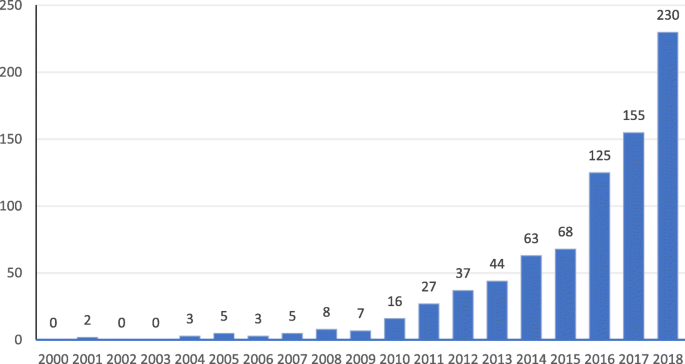
The distribution of STEM education publications over the years
Among the 798 articles, there were 549 articles with the word “STEM” (or STEAM, or written with the phrase of “science, technology, engineering, and mathematics”) included in the article’s title or both title and abstract and 249 articles without such identifiers included in the title but abstract only. The results suggest that many scholars tended to include STEM in the publications’ titles to highlight their research in or about STEM education. Figure 2 shows the number of publications per year where publications are distinguished depending on whether they used the term STEM in the title or only in the abstract. The number of publications in both categories had significant increases since 2010. Use of the acronym STEM in the title was growing at a faster rate than using the acronym only in the abstract.
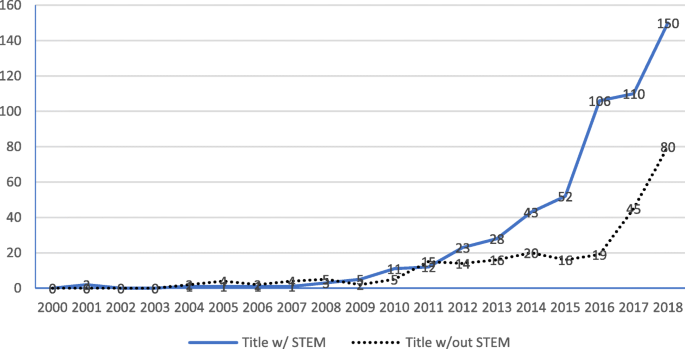
The trends of STEM education publications with vs. without STEM included in the title
Not all the publications that used the acronym STEM in the title and/or abstract reported on a study involving all four STEM areas. For each publication, we further examined the number of the four areas involved in the reported study.
Figure 3 presents the number of publications categorized by the number of the four areas involved in the study, breaking down the distribution of these 798 publications in terms of the content scope being focused on. Studies involving all four STEM areas are the most numerous with 488 (61.2%) publications, followed by involving one area (141, 17.7%), then studies involving both STEM and non-STEM (84, 10.5%), and finally studies involving two or three areas of STEM (72, 9%; 13, 1.6%; respectively). Publications that used the acronym STEAM in either the title or abstract were classified as involving both STEM and non-STEM. For example, both of the following publications were included in this category.
Dika and D’Amico ( 2016 ). “Early experiences and integration in the persistence of first-generation college students in STEM and non-STEM majors.” Journal of Research in Science Teaching , 53 (3), 368–383. (Note: this article focused on early experience in both STEM and Non-STEM majors.)
Sochacka, Guyotte, and Walther ( 2016 ). “Learning together: A collaborative autoethnographic exploration of STEAM (STEM+ the Arts) education.” Journal of Engineering Education , 105 (1), 15–42. (Note: this article focused on STEAM (both STEM and Arts).)
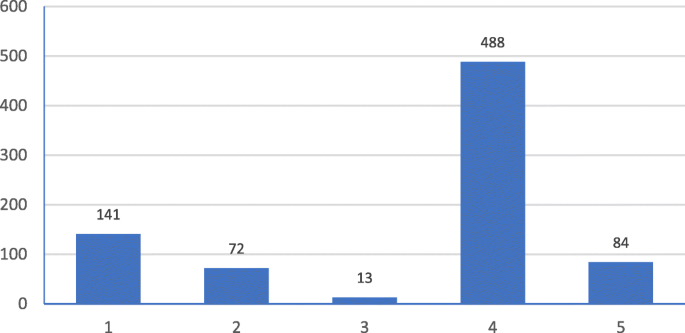
Publication distribution in terms of content scope being focused on. (Note: 1=single subject of STEM, 2=two subjects of STEM, 3=three subjects of STEM, 4=four subjects of STEM, 5=topics related to both STEM and non-STEM)
Figure 4 presents the number of publications per year in each of the five categories described earlier (category 1, one area of STEM; category 2, two areas of STEM; category 3, three areas of STEM; category 4, four areas of STEM; category 5, STEM and non-STEM). The category that had grown most rapidly since 2010 is the one involving all four areas. Recent growth in the number of publications in category 1 likely reflected growing interest of traditional individual disciplinary based educators in developing and sharing multidisciplinary and interdisciplinary scholarship in STEM education, as what was noted recently by Li and Schoenfeld ( 2019 ) with publications in IJ-STEM.
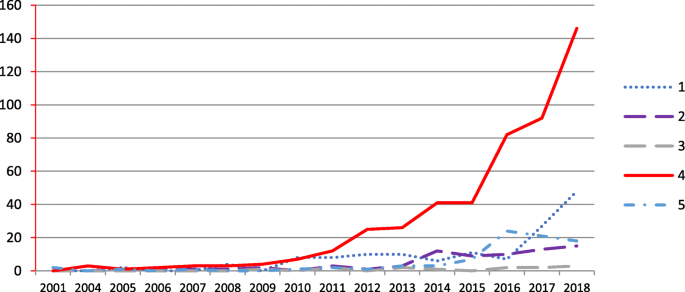
Publication distribution in terms of content scope being focused on over the years
Patterns of publications across different journals
Among the 36 journals that published STEM education articles, two are general education research journals (referred to as “subject-0”), 12 with their titles containing one discipline of STEM (“subject-1”), eight with journal’s titles covering two disciplines of STEM (“subject-2”), six covering three disciplines of STEM (“subject-3”), seven containing the word STEM (“subject-4”), and one in STEAM education (“subject-5”).
Table 2 shows that both subject-0 and subject-1 journals were usually mature journals with a long history, and they were all traditional subscription-based journals, except the Journal of Pre - College Engineering Education Research , a subject-1 journal established in 2011 that provided open access (OA). In comparison to subject-0 and subject-1 journals, subject-2 and subject-3 journals were relatively newer but still had quite many years of history on average. There are also some more journals in these two categories that provided OA. Subject-4 and subject-5 journals had a short history, and most provided OA. The results show that well-established journals had tended to focus on individual disciplines or education research in general. Multidisciplinary and interdisciplinary education journals were started some years later, followed by the recent establishment of several STEM or STEAM journals.
Table 2 also shows that subject-1, subject-2, and subject-4 journals published approximately a quarter each of the publications. The number of publications in subject-1 journals is interested, because we selected a relatively limited number of journals in this category. There are many other journals in the subject-1 category (as well as subject-0 journals) that we did not select, and thus it is very likely that we did not include some STEM education articles published in subject-0 or subject-1 journals that we did not include in our study.
Figure 5 shows the number of publications per year in each of the five categories described earlier (subject-0 through subject-5). The number of publications per year in subject-5 and subject-0 journals did not change much over the time period of the study. On the other hand, the number of publications per year in subject-4 (all 4 areas), subject-1 (single area), and subject-2 journals were all over 40 by the end of the study period. The number of publications per year in subject-3 journals increased but remained less than 30. At first sight, it may be a bit surprising that the number of publications in STEM education per year in subject-1 journals increased much faster than those in subject-2 journals over the past few years. However, as Table 2 indicates these journals had long been established with great reputations, and scholars would like to publish their research in such journals. In contrast to the trend in subject-1 journals, the trend in subject-4 journals suggests that STEM education journals collectively started to gain its own identity for publishing and sharing STEM education research.
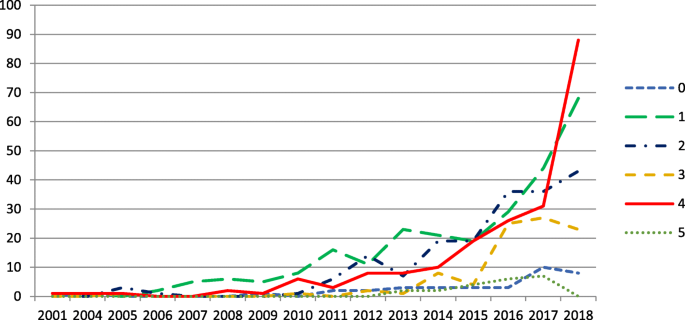
STEM education publication distribution across different journal categories over the years. (Note: 0=subject-0; 1=subject-1; 2=subject-2; 3=subject-3; 4=subject-4; 5=subject-5)
Figure 6 shows the number of STEM education publications in each journal where the bars are color-coded (yellow, subject-0; light blue, subject-1; green, subject-2; purple, subject-3; dark blue, subject-4; and black, subject-5). There is no clear pattern shown in terms of the overall number of STEM education publications across categories or journals, but very much individual journal-based performance. The result indicates that the number of STEM education publications might heavily rely on the individual journal’s willingness and capability of attracting STEM education research work and thus suggests the potential value of examining individual journal’s performance.
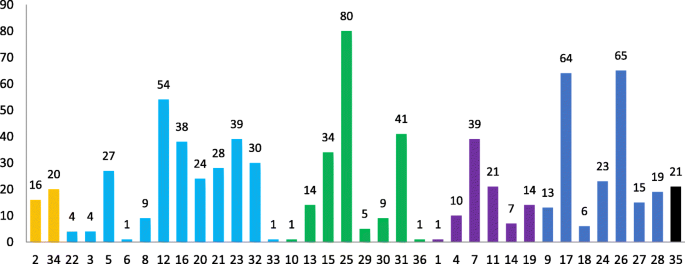
Publication distribution across all 36 individual journals across different categories with the same color-coded for journals in the same subject category
The top five journals in terms of the number of STEM education publications are Journal of Science Education and Technology (80 publications, journal number 25 in Fig. 6 ), Journal of STEM Education (65 publications, journal number 26), International Journal of STEM Education (64 publications, journal number 17), International Journal of Engineering Education (54 publications, journal number 12), and School Science and Mathematics (41 publications, journal number 31). Among these five journals, two journals are specifically on STEM education (J26, J17), two on two subjects of STEM (J25, J31), and one on one subject of STEM (J12).
Figure 7 shows the number of STEM education publications per year in each of these top five journals. As expected, based on earlier trends, the number of publications per year increased over the study period. The largest increase was in the International Journal of STEM Education (J17) that was established in 2014. As the other four journals were all established in or before 2000, J17’s short history further suggests its outstanding performance in attracting and publishing STEM education articles since 2014 (Li, 2018b ; Li, Froyd, & Wang, 2019 ). The increase was consistent with the journal’s recognition as the first STEM education journal for inclusion in SSCI starting in 2019 (Li, 2019a ).
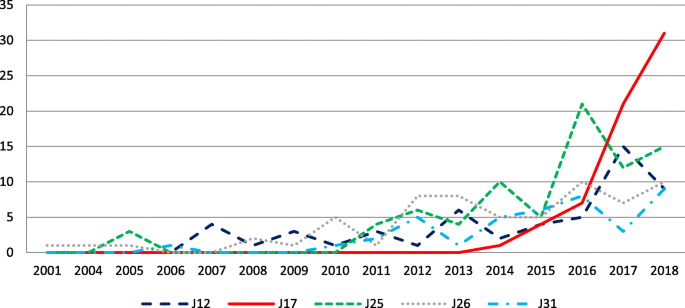
Publication distribution of selected five journals over the years. (Note: J12: International Journal of Engineering Education; J17: International Journal of STEM Education; J25: Journal of Science Education and Technology; J26: Journal of STEM Education; J31: School Science and Mathematics)
Top 10 countries/regions where scholars contributed journal publications in STEM education
Table 3 shows top countries/regions in terms of the number of publications, where the country/region was established by the authorship using the two different methods presented above. About 75% (depending on the method) of contributions were made by authors from the USA, followed by Australia, Canada, Taiwan, and UK. Only Africa as a continent was not represented among the top 10 countries/regions. The results are relatively consistent with patterns reported in the IJ-STEM study (Li, Froyd, & Wang, 2019 )
Further examination of Table 3 reveals that the two methods provide not only fairly consistent results but also yield some differences. For example, Israel and Germany had more publication credit if only the corresponding author was considered, but South Korea and Turkey had more publication credit when co-authors were considered. The results in Table 3 show that each method has value when analyzing and comparing publications by country/region or institution based on authorship.
Recognizing that, as shown in Fig. 1 , the number of publications per year increased rapidly since 2010, Table 4 shows the number of publications by country/region over a 10-year period (2009–2018) and Table 5 shows the number of publications by country/region over a 5-year period (2014–2018). The ranks in Tables 3 , 4 , and 5 are fairly consistent, but that would be expected since the larger numbers of publications in STEM education had occurred in recent years. At the same time, it is interesting to note in Table 5 some changes over the recent several years with Malaysia, but not Israel, entering the top 10 list when either method was used to calculate author's credit.
Patterns of single-author and multiple-author publications in STEM education
Since STEM education differs from traditional individual disciplinary education, we are interested in determining how common joint co-authorship with collaborations was in STEM education articles. Figure 8 shows that joint co-authorship was very common among these 798 STEM education publications, with 83.7% publications with two or more co-authors. Publications with two, three, or at least five co-authors were highest, with 204, 181, and 157 publications, respectively.
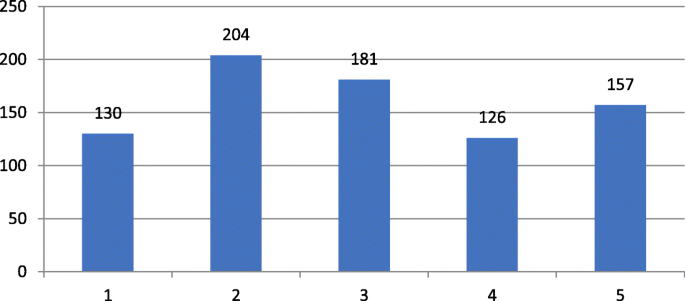
Number of publications with single or different joint authorship. (Note: 1=single author; 2=two co-authors; 3=three co-authors; 4=four co-authors; 5=five or more co-authors)
Figure 9 shows the number of publications per year using the joint authorship categories in Fig. 8 . Each category shows an increase consistent with the increase shown in Fig. 1 for all 798 publications. By the end of the time period, the number of publications with two, three, or at least five co-authors was the largest, which might suggest an increase in collaborations in STEM education research.
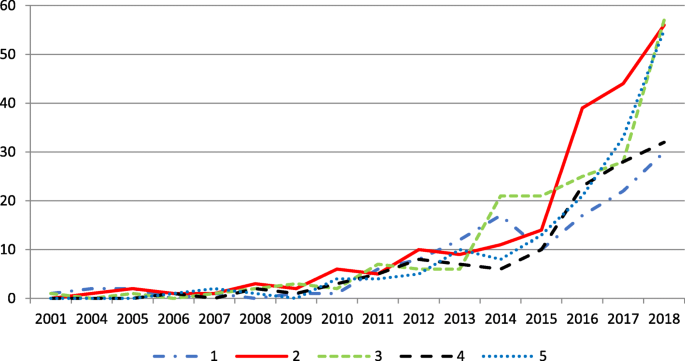
Publication distribution with single or different joint authorship over the years. (Note: 1=single author; 2=two co-authors; 3=three co-authors; 4=four co-authors; 5=five or more co-authors)
Co-authors can be from the same or different countries/regions. Figure 10 shows the number of publications per year by single authors (no collaboration), co-authors from the same country (collaboration in a country/region), and co-authors from different countries (collaboration across countries/regions). Each year the largest number of publications was by co-authors from the same country, and the number increased dramatically during the period of the study. Although the number of publications in the other two categories increased, the numbers of publications were noticeably fewer than the number of publications by co-authors from the same country.
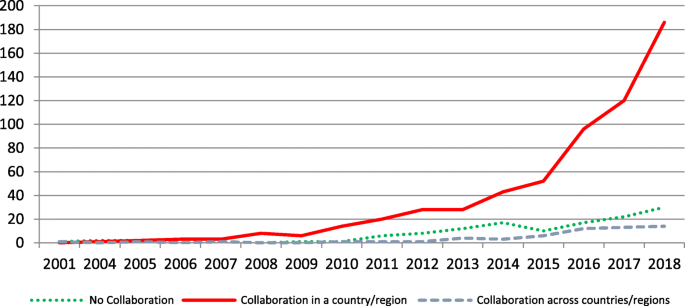
Publication distribution in authorship across different categories in terms of collaboration over the years
Published articles by research topics
Figure 11 shows the number of publications in each of the seven topic categories. The topic category of goals, policy, curriculum, evaluation, and assessment had almost half of publications (375, 47%). Literature reviews were included in this topic category, as providing an overview assessment of education and research development in a topic area or a field. Sample publications included in this category are listed as follows:
DeCoito ( 2016 ). “STEM education in Canada: A knowledge synthesis.” Canadian Journal of Science , Mathematics and Technology Education , 16 (2), 114–128. (Note: this article provides a national overview of STEM initiatives and programs, including success, criteria for effective programs and current research in STEM education.)
Ring-Whalen, Dare, Roehrig, Titu, and Crotty ( 2018 ). “From conception to curricula: The role of science, technology, engineering, and mathematics in integrated STEM units.” International Journal of Education in Mathematics Science and Technology , 6 (4), 343–362. (Note: this article investigates the conceptions of integrated STEM education held by in-service science teachers through the use of photo-elicitation interviews and examines how those conceptions were reflected in teacher-created integrated STEM curricula.)
Schwab et al. ( 2018 ). “A summer STEM outreach program run by graduate students: Successes, challenges, and recommendations for implementation.” Journal of Research in STEM Education , 4 (2), 117–129. (Note: the article details the organization and scope of the Foundation in Science and Mathematics Program and evaluates this program.)
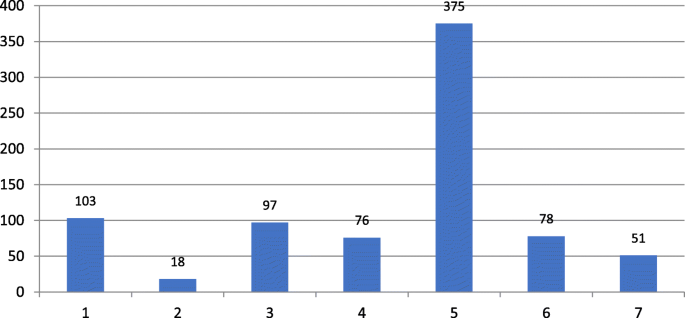
Frequencies of publications’ research topic distributions. (Note: 1=K-12 teaching, teacher and teacher education; 2=Post-secondary teacher and teaching; 3=K-12 STEM learner, learning, and learning environment; 4=Post-secondary STEM learner, learning, and learning environments; 5=Goals and policy, curriculum, evaluation, and assessment (including literature review); 6=Culture, social, and gender issues; 7=History, philosophy, Epistemology, and nature of STEM and STEM education)
The topic with the second most publications was “K-12 teaching, teacher and teacher education” (103, 12.9%), followed closely by “K-12 learner, learning, and learning environment” (97, 12.2%). The results likely suggest the research community had a broad interest in both teaching and learning in K-12 STEM education. The top three topics were the same in the IJ-STEM review (Li, Froyd, & Wang, 2019 ).
Figure 11 also shows there was a virtual tie between two topics with the fourth most cumulative publications, “post-secondary STEM learner & learning” (76, 9.5%) and “culture, social, and gender issues in STEM” (78, 9.8%), such as STEM identity, students’ career choices in STEM, and inclusion. This result is different from the IJ-STEM review (Li, Froyd, & Wang, 2019 ), where “post-secondary STEM teacher & teaching” and “post-secondary STEM learner & learning” were tied as the fourth most common topics. This difference is likely due to the scope of journals and the length of the time period being reviewed.
Figure 12 shows the number of publications per year in each topic category. As expected from the results in Fig. 11 the number of publications in topic category 5 (goals, policy, curriculum, evaluation, and assessment) was the largest each year. The numbers of publications in topic category 3 (K-12 learner, learning, and learning environment), 1 (K-12 teaching, teacher, and teacher education), 6 (culture, social, and gender issues in STEM), and 4 (post-secondary STEM learner and learning) were also increasing. Although Fig. 11 shows the number of publications in topic category 1 was slightly more than the number of publications in topic category 3 (see Fig. 11 ), the number of publications in topic category 3 was increasing more rapidly in recent years than its counterpart in topic category 1. This may suggest a more rapidly growing interest in K-12 STEM learner, learning, and learning environment. The numbers of publications in topic categories 2 and 7 were not increasing, but the number of publications in IJ-STEM in topic category 2 was notable (Li, Froyd, & Wang, 2019 ). It will be interesting to follow trends in the seven topic categories in the future.
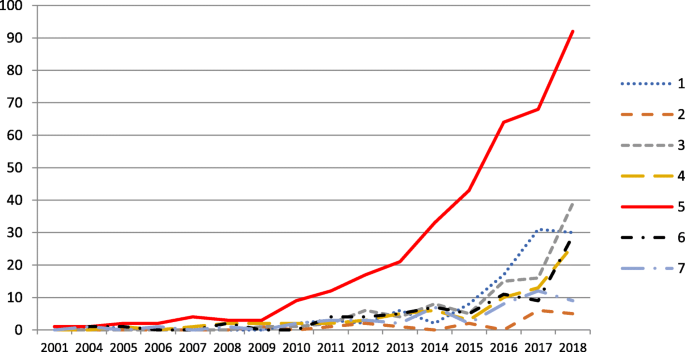
Publication distributions in terms of research topics over the years
Published articles by research methods
Figure 13 shows the number of publications per year by research methods in empirical studies. Publications with non-empirical studies are shown in a separate category. Although the number of publications in each of the four categories increased during the study period, there were many more publications presenting empirical studies than those without. For those with empirical studies, the number of publications using quantitative methods increased most rapidly in recent years, followed by qualitative and then mixed methods. Although there were quite many publications with non-empirical studies (e.g., theoretical or conceptual papers, literature reviews) during the study period, the increase of the number of publications in this category was noticeably less than empirical studies.
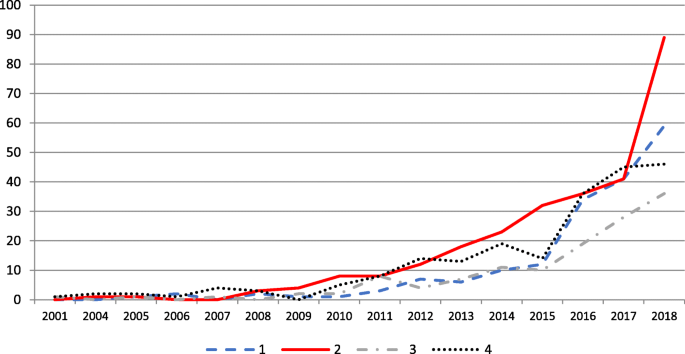
Publication distributions in terms of research methods over the years. (Note: 1=qualitative, 2=quantitative, 3=mixed, 4=Non-empirical)
Concluding remarks
The systematic analysis of publications that were considered to be in STEM education in 36 selected journals shows tremendous growth in scholarship in this field from 2000 to 2018, especially over the past 10 years. Our analysis indicates that STEM education research has been increasingly recognized as an important topic area and studies were being published across many different journals. Scholars still hold diverse perspectives about how research is designated as STEM education; however, authors have been increasingly distinguishing their articles with STEM, STEAM, or related words in the titles, abstracts, and lists of keywords during the past 10 years. Moreover, our systematic analysis shows a dramatic increase in the number of publications in STEM education journals in recent years, which indicates that these journals have been collectively developing their own professional identity. In addition, the International Journal of STEM Education has become the first STEM education journal to be accepted in SSCI in 2019 (Li, 2019a ). The achievement may mark an important milestone as STEM education journals develop their own identity for publishing and sharing STEM education research.
Consistent with our previous reviews (Li, Froyd, & Wang, 2019 ; Li, Wang, & Xiao, 2019 ), the vast majority of publications in STEM education research were contributed by authors from the USA, where STEM and STEAM education originated, followed by Australia, Canada, and Taiwan. At the same time, authors in some countries/regions in Asia were becoming very active in the field over the past several years. This trend is consistent with findings from the IJ-STEM review (Li, Froyd, & Wang, 2019 ). We certainly hope that STEM education scholarship continues its development across all five continents to support educational initiatives and programs in STEM worldwide.
Our analysis has shown that collaboration, as indicated by publications with multiple authors, has been very common among STEM education scholars, as that is often how STEM education distinguishes itself from the traditional individual disciplinary based education. Currently, most collaborations occurred among authors from the same country/region, although collaborations across cross-countries/regions were slowly increasing.
With the rapid changes in STEM education internationally (Li, 2019b ), it is often difficult for researchers to get an overall sense about possible hot topics in STEM education especially when STEM education publications appeared in a vast array of journals across different fields. Our systematic analysis of publications has shown that studies in the topic category of goals, policy, curriculum, evaluation, and assessment have been the most prevalent, by far. Our analysis also suggests that the research community had a broad interest in both teaching and learning in K-12 STEM education. These top three topic categories are the same as in the IJ-STEM review (Li, Froyd, & Wang, 2019 ). Work in STEM education will continue to evolve and it will be interesting to review the trends in another 5 years.
Encouraged by our recent IJ-STEM review, we began this review with an ambitious goal to provide an overview of the status and trends of STEM education research. In a way, this systematic review allowed us to achieve our initial goal with a larger scope of journal selection over a much longer period of publication time. At the same time, there are still limitations, such as the decision to limit the number of journals from which we would identify publications for analysis. We understand that there are many publications on STEM education research that were not included in our review. Also, we only identified publications in journals. Although this is one of the most important outlets for scholars to share their research work, future reviews could examine publications on STEM education research in other venues such as books, conference proceedings, and grant proposals.
Availability of data and materials
The data and materials used and analyzed for the report are publicly available at the various journal websites.
Journals containing the word "computers" or "ICT" appeared automatically when searching with the word "technology". Thus, the word of "computers" or "ICT" was taken as equivalent to "technology" if appeared in a journal's name.
Abbreviations
Information and Communications Technology
International Journal of STEM Education
Kindergarten–Grade 12
Science, Mathematics, Engineering, and Technology
Science, Technology, Engineering, Arts, and Mathematics
Science, Technology, Engineering, and Mathematics
Borrego, M., Foster, M. J., & Froyd, J. E. (2015). What is the state of the art of systematic review in engineering education? Journal of Engineering Education, 104 (2), 212–242. https://doi.org/10.1002/jee.20069 .
Article Google Scholar
Bray, A., & Tangney, B. (2017). Technology usage in mathematics education research – a systematic review of recent trends. Computers & Education, 114 , 255–273.
Brown, J. (2012). The current status of STEM education research. Journal of STEM Education: Innovations & Research, 13 (5), 7–11.
Google Scholar
Christenson, J. (2011). Ramaley coined STEM term now used nationwide . Winona Daily News Retrieved from http://www.winonadailynews.com/news/local/article_457afe3e-0db3-11e1-abe0-001cc4c03286.html Accessed on 16 Jan 2018.
Chute, E. (2009). STEM education is branching out . Pittsburgh Post-Gazette Feb 9, 2009. https://www.post-gazette.com/news/education/2009/02/10/STEM-education-is-branching-out/stories/200902100165 Accessed on 2 Jan 2020.
DeCoito, I. (2016). STEM education in Canada: A knowledge synthesis. Canadian Journal of Science, Mathematics and Technology Education, 16 (2), 114–128.
Dika, S. L., & D'Amico, M. M. (2016). Early experiences and integration in the persistence of first-generation college students in STEM and non-STEM majors. Journal of Research in Science Teaching, 53 (3), 368–383.
English, L. D. (2016). STEM education K-12: Perspectives on integration. International Journal of STEM Education, 3 , 3. https://doi.org/10.1186/s4059%204-016-0036-1 .
Erduran, S., Ozdem, Y., & Park, J.-Y. (2015). Research trends on argumentation in science education: A journal content analysis from 1998-2014. International Journal of STEM Education, 2 , 5. https://doi.org/10.1186/s40594-015-0020-1 .
Gonzalez, H. B. & Kuenzi, J. J. (2012). Science, technology, engineering, and mathematics (STEM) education: A primer. CRS report for congress, R42642, https://fas.org/sgp/crs/misc/R42642.pdf Accessed on 2 Jan 2020.
Henderson, C., Beach, A., & Finkelstein, N. (2011). Facilitating change in undergraduate STEM instructional practices: An analytic review of the literature. Journal of Research in Science Teaching, 48 (8), 952–984.
Honey, M., Pearson, G., & Schweingruber, A. (2014). STEM integration in K-12 education: Status, prospects, and an agenda for research . Washington: National Academies Press.
Howard, G. S., Cole, D. A., & Maxwell, S. E. (1987). Research productivity in psychology based on publication in the journals of the American Psychological Association. American Psychologist, 42 (11), 975–986.
Johnson, C. C., Peters-Burton, E. E., & Moore, T. J. (2015). STEM roadmap: A framework for integration . London: Taylor & Francis.
Book Google Scholar
Kelley, T. R., & Knowles, J. G. (2016). A conceptual framework for integrated STEM education. International Journal of STEM Education, 3 , 11. https://doi.org/10.1186/s40594-016-0046-z .
Kilpatrick, J. (1992). A history of research in mathematics education. In D. A. Grouws (Ed.), Handbook of research on mathematics teaching and learning (pp. 3–38). New York: Macmillan.
Kim, A. Y., Sinatra, G. M., & Seyranian, V. (2018). Developing a STEM identity among young women: A social identity perspective. Review of Educational Research, 88 (4), 589–625.
Li, Y. (2014). International journal of STEM education – a platform to promote STEM education and research worldwide. International Journal of STEM Education, 1 , 1. https://doi.org/10.1186/2196-7822-1-1 .
Li, Y. (2018a). Journal for STEM education research – promoting the development of interdisciplinary research in STEM education. Journal for STEM Education Research, 1 (1–2), 1–6. https://doi.org/10.1007/s41979-018-0009-z .
Li, Y. (2018b). Four years of development as a gathering place for international researchers and readers in STEM education. International Journal of STEM Education, 5 , 54. https://doi.org/10.1186/s40594-018-0153-0 .
Li, Y. (2019a). Five years of development in pursuing excellence in quality and global impact to become the first journal in STEM education covered in SSCI. International Journal of STEM Education, 6 , 42. https://doi.org/10.1186/s40594-019-0198-8 .
Li, Y. (2019b). STEM education research and development as a rapidly evolving and international field. 数学教育学报(Journal of Mathematics Education), 28 (3), 42–44.
Li, Y., Froyd, J. E., & Wang, K. (2019). Learning about research and readership development in STEM education: A systematic analysis of the journal’s publications from 2014 to 2018. International Journal of STEM Education, 6 , 19. https://doi.org/10.1186/s40594-019-0176-1 .
Li, Y., & Schoenfeld, A. H. (2019). Problematizing teaching and learning mathematics as ‘given’ in STEM education. International Journal of STEM Education, 6 , 44. https://doi.org/10.1186/s40594-019-0197-9 .
Li, Y., Wang, K., & Xiao, Y. (2019). Exploring the status and development trends of STEM education research: A review of research articles in selected journals published between 2000 and 2018. 数学教育学报(Journal of Mathematics Education), 28 (3), 45–52.
Lin, T.-J., Lin, T.-C., Potvin, P., & Tsai, C.-C. (2019). Research trends in science education from 2013 to 2017: A systematic content analysis of publications in selected journals. International Journal of Science Education, 41 (3), 367–387.
Margot, K. C., & Kettler, T. (2019). Teachers’ perception of STEM integration and education: A systematic literature review. International Journal of STEM Education, 6 , 2. https://doi.org/10.1186/s40594-018-0151-2 .
Minichiello, A., Hood, J. R., & Harkness, D. S. (2018). Bring user experience design to bear on STEM education: A narrative literature review. Journal for STEM Education Research, 1 (1–2), 7–33.
Minner, D. D., Levy, A. J., & Century, J. (2010). Inquiry-based science instruction – what is it and does it matter? Results from a research synthesis years 1984 to 2002. Journal of Research in Science Teaching, 47 (4), 474–496.
Mizell, S., & Brown, S. (2016). The current status of STEM education research 2013-2015. Journal of STEM Education: Innovations & Research, 17 (4), 52–56.
National Research Council. (2012). Discipline-based education research: Understanding and improving learning in undergraduate science and engineering . Washington DC: National Academies Press.
National Science Foundation (1998). Information technology: Its impact on undergraduate education in science, mathematics, engineering, and technology. (NSF 98–82), April 18–20, 1996. http://www.nsf.gov/cgi-bin/getpub?nsf9882 Accessed 16 Jan 2018.
Raju, P. K., & Sankar, C. S. (2003). Editorial. Journal of STEM Education: Innovations & Research, 4 (3&4), 2.
Ring-Whalen, E., Dare, E., Roehrig, G., Titu, P., & Crotty, E. (2018). From conception to curricula: The role of science, technology, engineering, and mathematics in integrated STEM units. International Journal of Education in Mathematics, Science and Technology, 6 (4), 343–362.
Schreffler, J., Vasquez III, E., Chini, J., & James, W. (2019). Universal design for learning in postsecondary STEM education for students with disabilities: A systematic literature review. International Journal of STEM Education, 6 , 8. https://doi.org/10.1186/s40594-019-0161-8 .
Schwab, D. B., Cole, L. W., Desai, K. M., Hemann, J., Hummels, K. R., & Maltese, A. V. (2018). A summer STEM outreach program run by graduate students: Successes, challenges, and recommendations for implementation. Journal of Research in STEM Education, 4 (2), 117–129.
Sochacka, N. W., Guyotte, K. W., & Walther, J. (2016). Learning together: A collaborative autoethnographic exploration of STEAM (STEM+ the Arts) education. Journal of Engineering Education, 105 (1), 15–42.
Sokolowski, A., Li, Y., & Willson, V. (2015). The effects of using exploratory computerized environments in grades 1 to 8 mathematics: A meta-analysis of research. International Journal of STEM Education, 2 , 8. https://doi.org/10.1186/s40594-015-0022-z .
Thibaut, L., Ceuppens, S., De Loof, H., De Meester, J., Goovaerts, L., Struyf, A., Pauw, J. B., Dehaene, W., Deprez, J., De Cock, M., Hellinckx, L., Knipprath, H., Langie, G., Struyven, K., Van de Velde, D., Van Petegem, P., & Depaepe, F. (2018). Integrated STEM education: A systematic review of instructional practices in secondary education. European Journal of STEM Education, 3 (1), 2.
Tsai, C. C., & Wen, L. M. C. (2005). Research and trends in science education from 1998 to 2002: A content analysis of publication in selected journals. International Journal of Science Education, 27 (1), 3–14.
United States Congress House Committee on Science. (1998). The state of science, math, engineering, and technology (SMET) education in America, parts I-IV, including the results of the Third International Mathematics and Science Study (TIMSS): hearings before the Committee on Science, U.S. House of Representatives, One Hundred Fifth Congress, first session, July 23, September 24, October 8 and 29, 1997. Washington: U.S. G.P.O.
Vasquez, J., Sneider, C., & Comer, M. (2013). STEM lesson essentials, grades 3–8: Integrating science, technology, engineering, and mathematics . Portsmouth, NH: Heinemann.
Wu, S. P. W., & Rau, M. A. (2019). How students learn content in science, technology, engineering, and mathematics (STEM) through drawing activities. Educational Psychology Review . https://doi.org/10.1007/s10648-019-09467-3 .
Xu, M., Williams, P. J., Gu, J., & Zhang, H. (2019). Hotspots and trends of technology education in the International Journal of Technology and Design Education: 2000-2018. International Journal of Technology and Design Education . https://doi.org/10.1007/s10798-019-09508-6 .
Download references
Not applicable
Author information
Authors and affiliations.
Texas A&M University, College Station, TX, 77843-4232, USA
Yeping Li & Yu Xiao
Nicholls State University, Thibodaux, LA, 70310, USA
Ohio State University, Columbus, OH, 43210, USA
Jeffrey E. Froyd
You can also search for this author in PubMed Google Scholar
Contributions
YL conceptualized the study and drafted the manuscript. KW and YX contributed with data collection, coding, and analyses. JEF reviewed drafts and contributed to manuscript revisions. All authors read and approved the final manuscript.
Corresponding author
Correspondence to Yeping Li .
Ethics declarations
Competing interests.
The authors declare that they have no competing interests.
Additional information
Publisher’s note.
Springer Nature remains neutral with regard to jurisdictional claims in published maps and institutional affiliations.
Rights and permissions
Open Access This article is distributed under the terms of the Creative Commons Attribution 4.0 International License ( http://creativecommons.org/licenses/by/4.0/ ), which permits unrestricted use, distribution, and reproduction in any medium, provided you give appropriate credit to the original author(s) and the source, provide a link to the Creative Commons license, and indicate if changes were made.
Reprints and permissions
About this article
Cite this article.
Li, Y., Wang, K., Xiao, Y. et al. Research and trends in STEM education: a systematic review of journal publications. IJ STEM Ed 7 , 11 (2020). https://doi.org/10.1186/s40594-020-00207-6
Download citation
Received : 10 February 2020
Accepted : 12 February 2020
Published : 10 March 2020
DOI : https://doi.org/10.1186/s40594-020-00207-6
Share this article
Anyone you share the following link with will be able to read this content:
Sorry, a shareable link is not currently available for this article.
Provided by the Springer Nature SharedIt content-sharing initiative
- Journal publication
- Literature review
- STEM education research
share this!
April 29, 2024
This article has been reviewed according to Science X's editorial process and policies . Editors have highlighted the following attributes while ensuring the content's credibility:
fact-checked
peer-reviewed publication
trusted source
Scientists discover a new type of porous material that can store greenhouse gases
by Victoria Masterson, Heriot-Watt University
![Synthetic route for the [4[2+3]+6]cage molecule. Credit: Nature Synthesis (2024). DOI: 10.1038/s44160-024-00531-7 Scientists discover a new type of porous material that can store greenhouse gases](https://scx1.b-cdn.net/csz/news/800a/2024/scientists-discover-a-5.jpg)
A new type of porous material that can store carbon dioxide and other greenhouse gases has been developed by a team of scientists jointly led by Heriot-Watt University in Edinburgh, Scotland.
In a collaboration with the University of Liverpool, Imperial College London, the University of Southampton, and East China University of Science and Technology in China, the team used computer modeling to accurately predict how molecules would assemble themselves into the new type of porous material.
The research, published in the journal Nature Synthesis , details how the scientists created hollow, cage-like molecules with high storage capacities for greenhouse gases like carbon dioxide and sulfur hexafluoride. Sulfur hexafluoride is more potent greenhouse gas than carbon dioxide and can last thousands of years in the atmosphere.
These cage molecules were assembled using other cages to create a new type of porous material that the scientists say is the first of its kind in its porous "cage of cages" structure.
Materials scientist Dr. Marc Little, an Assistant Professor at Heriot-Watt University's Institute of Chemical Sciences and an expert in porous materials, jointly led the research.
He said, "This is an exciting discovery because we need new porous materials to help solve society's biggest challenges, such as capturing and storing greenhouse gases ."
Computer modeling specialists at Imperial College London and the University of Southampton created simulations to help the team understand and predict how their cage molecules would assemble into this new type of porous material.
Integral to the team were Professor Kim Jelfs from Imperial's Department of Chemistry and the Institute for Digital Molecular Design and Fabrication (DigiFAB), and Professor Andy Cooper from the University of Liverpool and Materials Innovation Factory.
Dr. Little added, "Combining computational studies like ours with new AI technologies could create an unprecedented supply of new materials to solve the most pressing societal challenges, and this study is an important step in this direction."
Dr. Little added that molecules with complex structures could also be used to remove toxic compounds known as volatile organic compounds from the air and could play an important role in medical science.
"We see this study as an important step towards unlocking such applications in the future," he said.
Journal information: Nature Synthesis
Provided by Heriot-Watt University
Explore further
Feedback to editors

Too many vehicles, slow reactions and reckless merging: New math model explains how traffic and bacteria move
46 minutes ago

Researchers discover new lantibiotic produced by staphylococci
7 hours ago

Study says California's 2023 snowy rescue from megadrought was a freak event. Don't get used to it
8 hours ago

'Sour Patch' adults: 1 in 8 grown-ups love extreme tartness, study shows

Long snouts protect foxes when they dive headfirst into snow, study finds

Laser imaging could offer early detection for at-risk artwork
9 hours ago

Tibetan plateau had broader social dimensions than previously thought, suggests study

Machine learning classifies 191 of the world's most damaging viruses

Theoretical biologists test two modes of social reasoning and find surprising truths in simplicity

It's all in the smile: New research finds politicians can influence voters with facial expressions
10 hours ago
Relevant PhysicsForums posts
Ideas for a project in computational chemistry.
Apr 25, 2024
Very confused about Naunyn definition of acid and base
Apr 24, 2024
Can you eat the Periodic Table?
Apr 23, 2024
New Insight into the Chemistry of Solvents
Apr 17, 2024
Separation of KCl from potassium chromium(III) PDTA
Apr 16, 2024
Zirconium Versus Zirconium Carbide For Use With Galinstan
Mar 29, 2024
More from Chemistry
Related Stories

Porous liquid holds bigger molecules
Feb 24, 2020

Porous crystals bind fluorine-containing greenhouse gases
Jul 22, 2022

Cage molecules act as molecular sieves for hydrogen isotope separation
Nov 1, 2019

Research team designs new porous materials to advance environmental remediation research
Mar 18, 2024

Porous material for selective trapping of carbon dioxide and toxic gases
Apr 4, 2023

Researchers can customize cavities in new porous material
Jun 8, 2022
Recommended for you

Researchers improve the plasticity of ceramic materials at room temperature
13 hours ago

Microgravity-grown crystals reveal new insights into protein structures
14 hours ago

Researchers achieve electrosynthesis via superwetting organic-solid-water interfaces

Scientists discover safer alternative for an explosive reaction used for more than 100 years
Apr 26, 2024

More efficient molecular motor widens potential applications

Thiol-ene click reaction offers a novel approach to fabricate elastic ferroelectrics
Let us know if there is a problem with our content.
Use this form if you have come across a typo, inaccuracy or would like to send an edit request for the content on this page. For general inquiries, please use our contact form . For general feedback, use the public comments section below (please adhere to guidelines ).
Please select the most appropriate category to facilitate processing of your request
Thank you for taking time to provide your feedback to the editors.
Your feedback is important to us. However, we do not guarantee individual replies due to the high volume of messages.
E-mail the story
Your email address is used only to let the recipient know who sent the email. Neither your address nor the recipient's address will be used for any other purpose. The information you enter will appear in your e-mail message and is not retained by Phys.org in any form.
Newsletter sign up
Get weekly and/or daily updates delivered to your inbox. You can unsubscribe at any time and we'll never share your details to third parties.
More information Privacy policy
Donate and enjoy an ad-free experience
We keep our content available to everyone. Consider supporting Science X's mission by getting a premium account.
E-mail newsletter

IMAGES
VIDEO
COMMENTS
Here are some Research Titles and Topics for G.A.S (GAS) Strand Students. Please take note that some of these titles are subject for revision if your teacher...
Topic: Coping Strategies. Sample Title: Coping Strategies of GAS Students under the New Normal. More Qualitative Research Titles. 1. Perceptions on Hybrid Learning: A Qualitative Study among GAS Students. 2. Inquiry-Based Learning: Experiences and Challenges of Students in the General Academic Strand.
The GAS strand was created to enable learners who struggle to make decisions to continue with any college program. This may have an influence on the students' decision regarding the course they will take. ... Review Related Literature This chapter includes the ideas, finished thesis, generalization and conclusions, methodologies and others ...
Under the GAS or General Academic Strand, interdisciplinary studies come first. You may be considering different subjects teaming up to tackle significant challenges. It can also be societal challenges, or you can analyze the efficiency of various teaching approaches. It's broad, and there's a lot to possibly become research topics. HUMSS ...
This document discusses a research paper about Grade 11 students who chose the General Academic Strand (GAS) in senior high school. It will examine their demographic profiles, considerations for choosing GAS, and alternative strands considered. The theoretical framework is John Holland's Theory of Career Choice, which says career choices are influenced by personality and environment. The study ...
REVIEW OF RELATED LITERATURE This presents The Review of Related Literature to support the researcher's study and be able to understand the research clearly. This Review of Related Literature presents the article focused on the real reason why the General Academic Strand of the K to 12 programs was implemented.
significant topics today in the field of educational research specifically in the basic education is the learning approach adopted by the students in learning a particular task (Espinosa, 2014).
The researchers conducted this study to know the factors that affect the concentration of Grade 12 General Academic Strand (GAS) students. The researchers used descriptive design in such a way that the survey questionnaire was administered to thirty (30) Grade 12 GAS students chosen through random sampling.
Introduction This study aimed to identify the teaching of Senior High School General Academic Strand (GAS) Teachers in the City Schools Division of Urdaneta and the problems encountered with an end view of an intervention program for a more effective Senior High School implementation. Methods The research work used percentage and means to analyze profiles and responses and Pearson r to ...
The academic readiness in Biology of the General Academic Strand (GAS) learners was the focus of the study, Biology Aptitude test was the basis in developing a supplemental learning material. ... Using descriptive-survey research design, it intended to look into the. Grade 12 General Academic Strand ( GAS) academic readiness through Biology ...
GAS aims to: Cover various subjects and topics including Humanities, Social Sciences, Organization, and Management. Give students the freedom and ability to pursue any undergraduate program under the three other strands in the future. Develop your communication and writing skills. Learn about Empowerment Technologies.
That's actually one of the best advantages a student can get when choosing GAS over the other Senior High School strands. It gives a student the leverage to find his own strengths, as well as fresh perspectives on the new things he learns from its wide range of subjects. This opportunity will definitely prepare a student for college well and ...
General Academic Strand Reseach Study - Free download as Powerpoint Presentation (.ppt / .pptx), PDF File (.pdf), Text File (.txt) or view presentation slides online. This document discusses a qualitative study on the significance of including the General Academic Strand (GAS) among senior high school strands in the Philippines. GAS provides an option for students who are undecided on their ...
What are the effects of taking the GAS strand on selected college students? 5 answers Taking the GAS strand has been found to have positive effects on college students. One study found that students who experienced a gas safety system were able to rapidly escape dangerous situations by directly experiencing gas use and receiving prior education about gas safety accidents.
This is a subject from the special core curriculum subjects for the STEM Strand. Elective 1. These may be taken from any of the Tracks or Strands. Elective 2. Work Immersion/Research/Career Advocacy/Culminating Activity. This subject may be a combination of the four options provided, especially when there is a shortage of work immersion options.
30. Gasoline Storage and Safety: Evaluate safety protocols for storing gasoline at home. 31. Gasoline Substitutes for Cooking: Explore alternative cooking fuels to reduce reliance on gasoline. 32. Gasoline Sulfur Content and Environmental Impact: Analyze the environmental consequences of sulfur content in gasoline.
While the other strands are career-specific, the General Academic Strand is great for students who are still undecided on which track to take. You can choose electives from the different academic strands under this track. These subjects include Humanities, Social Sciences, Applied Economics, Organization and Management, and Disaster Preparedness.
Take the General Academic Strand (GAS). Unlike other K to 12 tracks and strands that are specific to a career, GAS gives you the chance to weigh your options. GASis a Senior High School strand that takes on a generalist approach in preparing students for college. It covers various disciplines like Humanities, Social Sciences, Organization, and ...
View Cantoria Research Plan - GAS Strand .docx from CHEMISTRY 1023 at Surigao State College of Technology - Surigao City. Title: Breakthroughs and Transcending Borders in GAS Strand Initial Research ... print materials A. List of concepts and definitions related to the topic B. List of references read April 10, ...
The Purpose of the Research The main purpose of the research is to consider how oil and gas industry affects the economy of the country. Evaluation of US Natural Gas Industry. The Act's aim was to protect the consumers from the emerging monopolies in the natural gas industry through price regulation of the natural gas.
With the rapid increase in the number of scholarly publications on STEM education in recent years, reviews of the status and trends in STEM education research internationally support the development of the field. For this review, we conducted a systematic analysis of 798 articles in STEM education published between 2000 and the end of 2018 in 36 journals to get an overview about developments ...
60 Suggested Research Topics/ Titles for HUMSS/GASYou can innovate or expand the suggested research topics/titles#researchproject #practicalresearch #research
3 Basic tips on writing a good research paper title. How to write an effective title and abstract and choose appropriate keywords. One tip we can give right away is that you should first have a working (rough) title when you start the paper and then refine/finalize it once you've completed the paper (or the first draft). Hope that helps.
A new type of porous material that can store carbon dioxide and other greenhouse gases has been developed by a team of scientists jointly led by Heriot-Watt University in Edinburgh, Scotland.